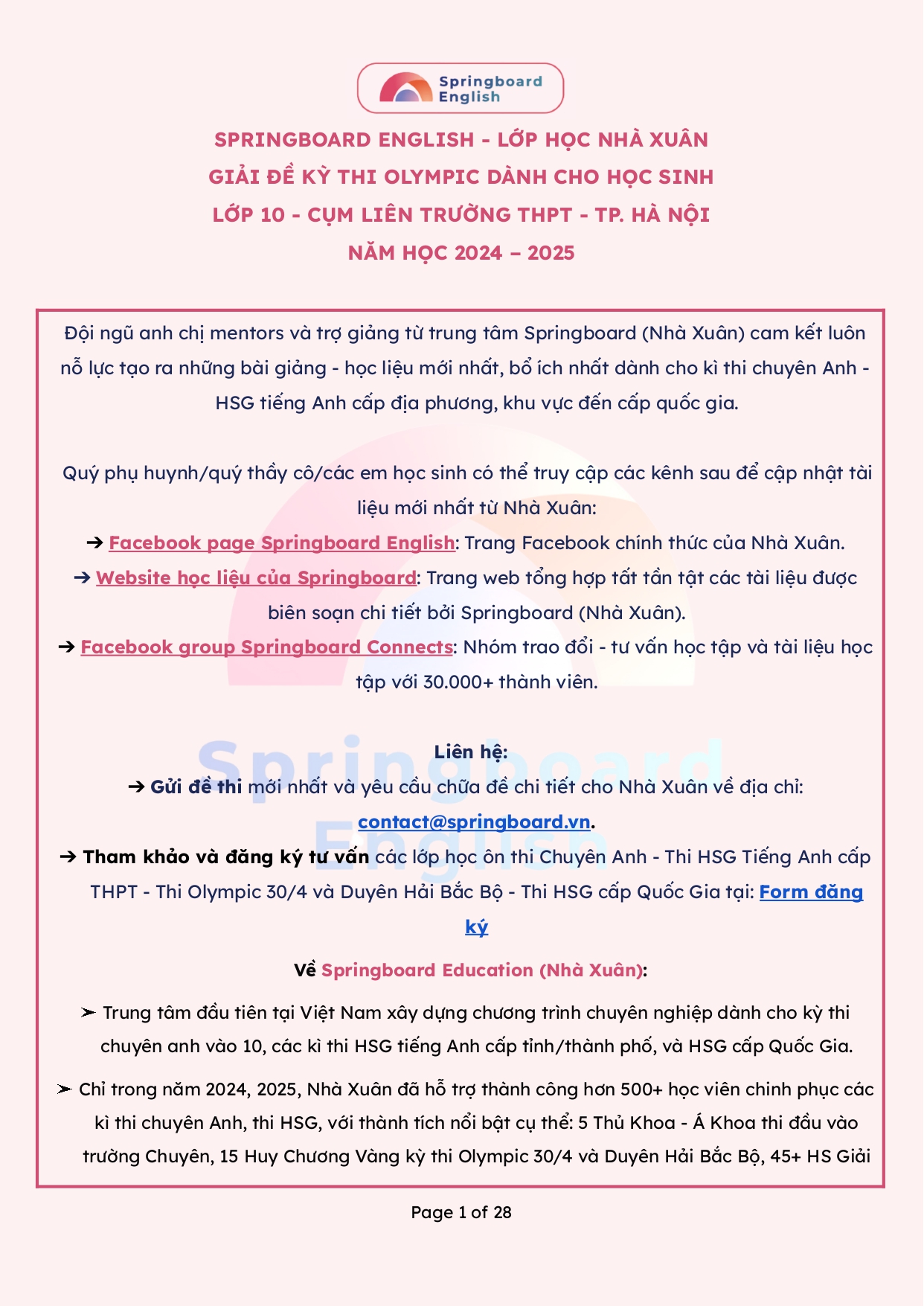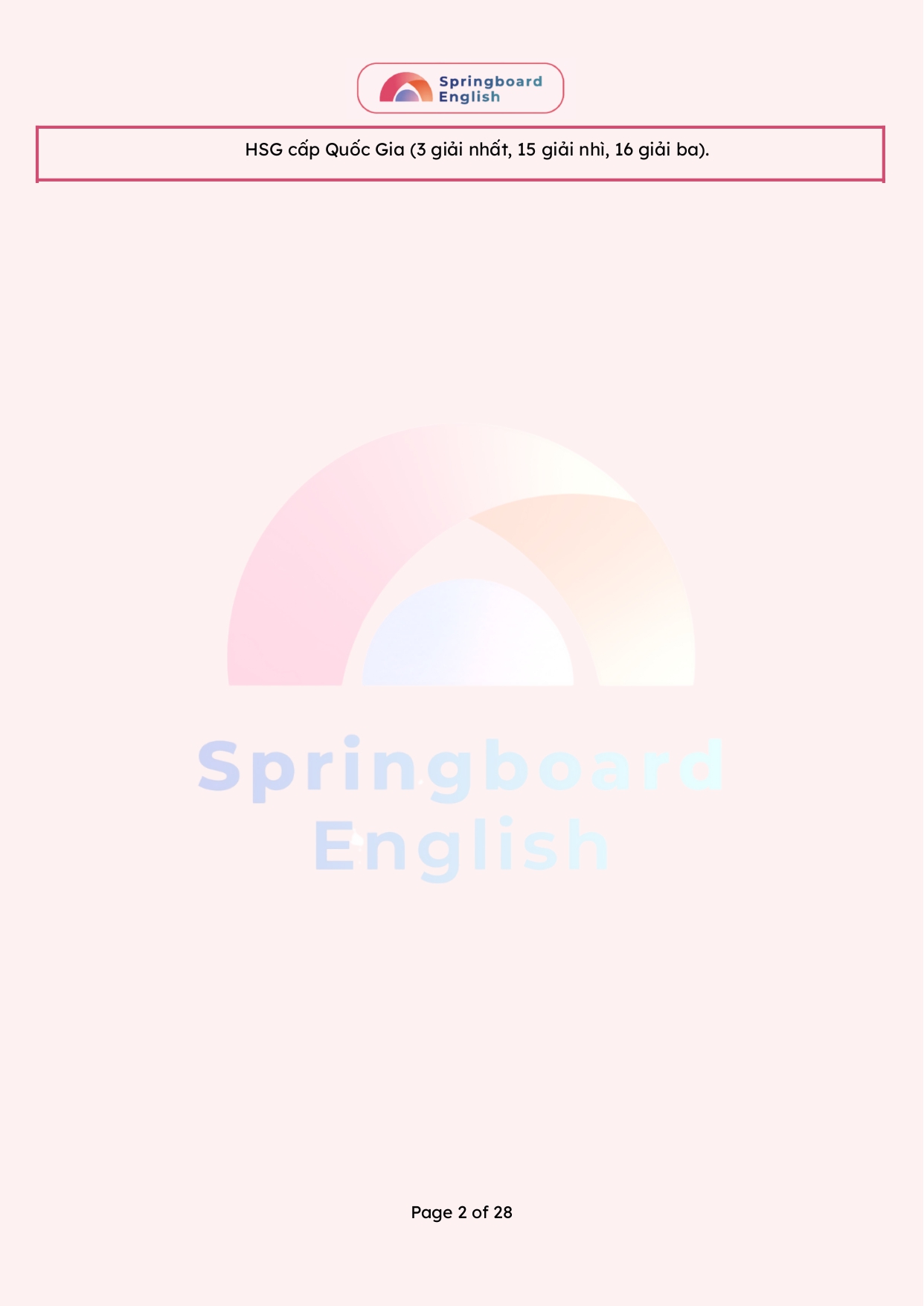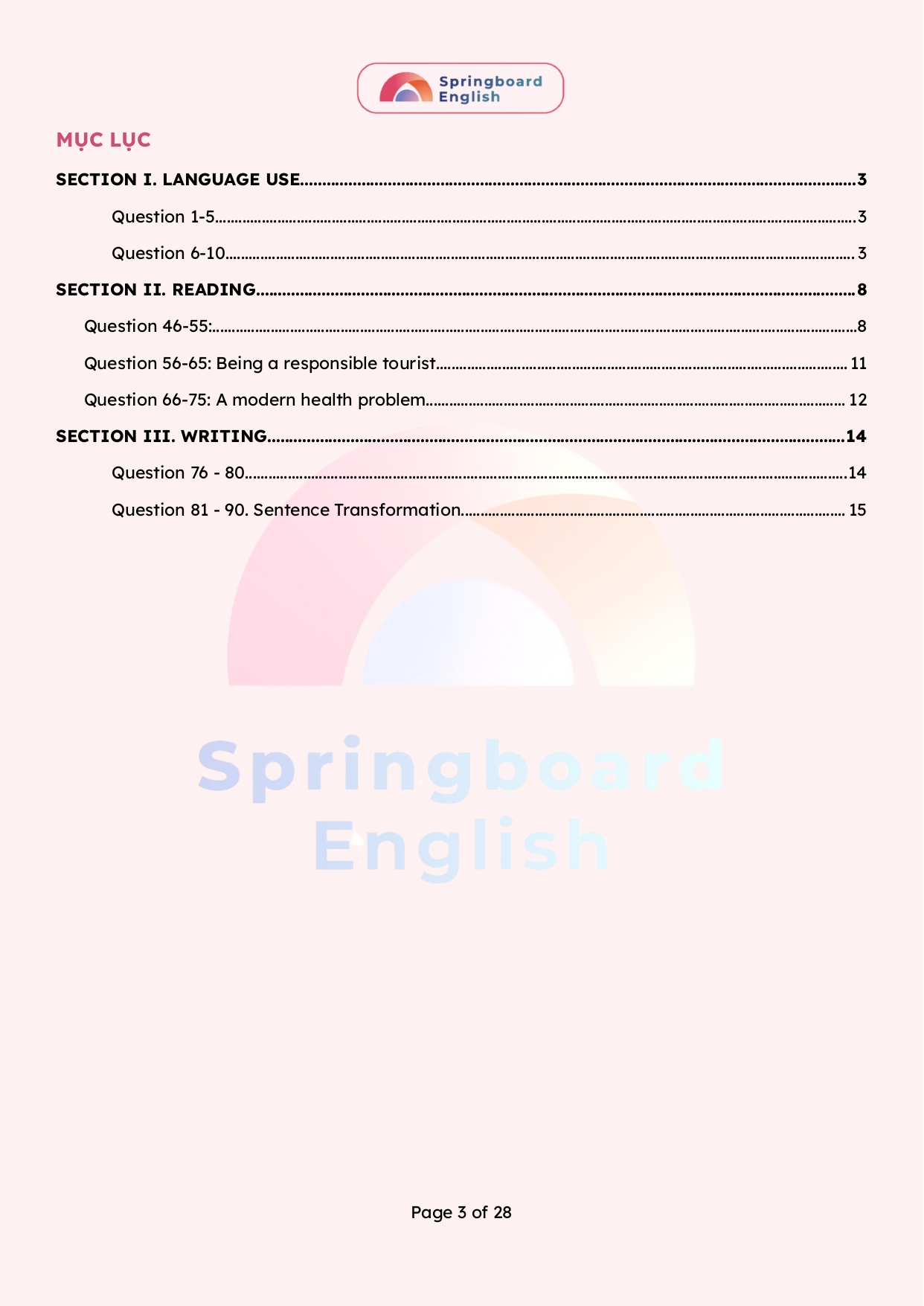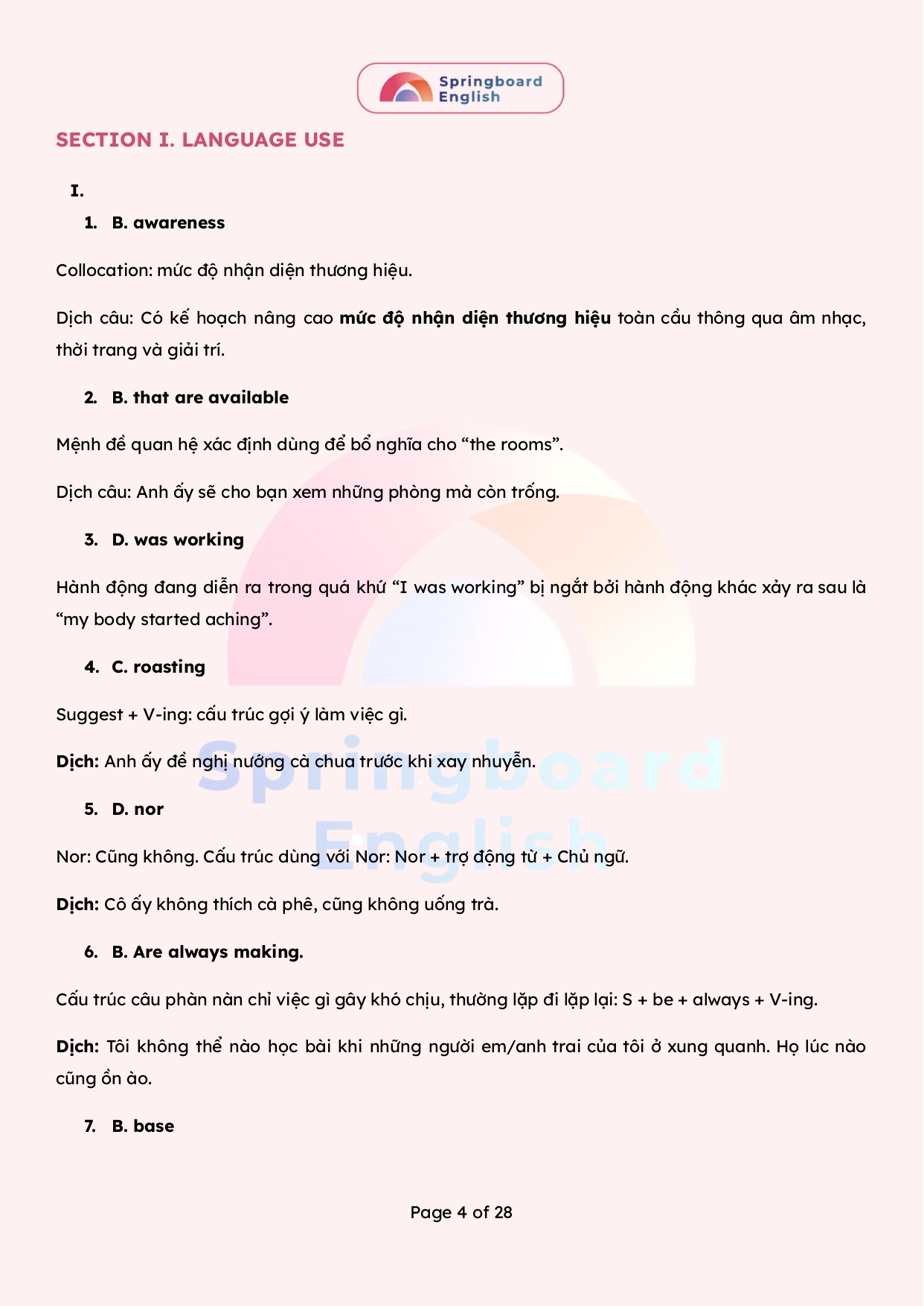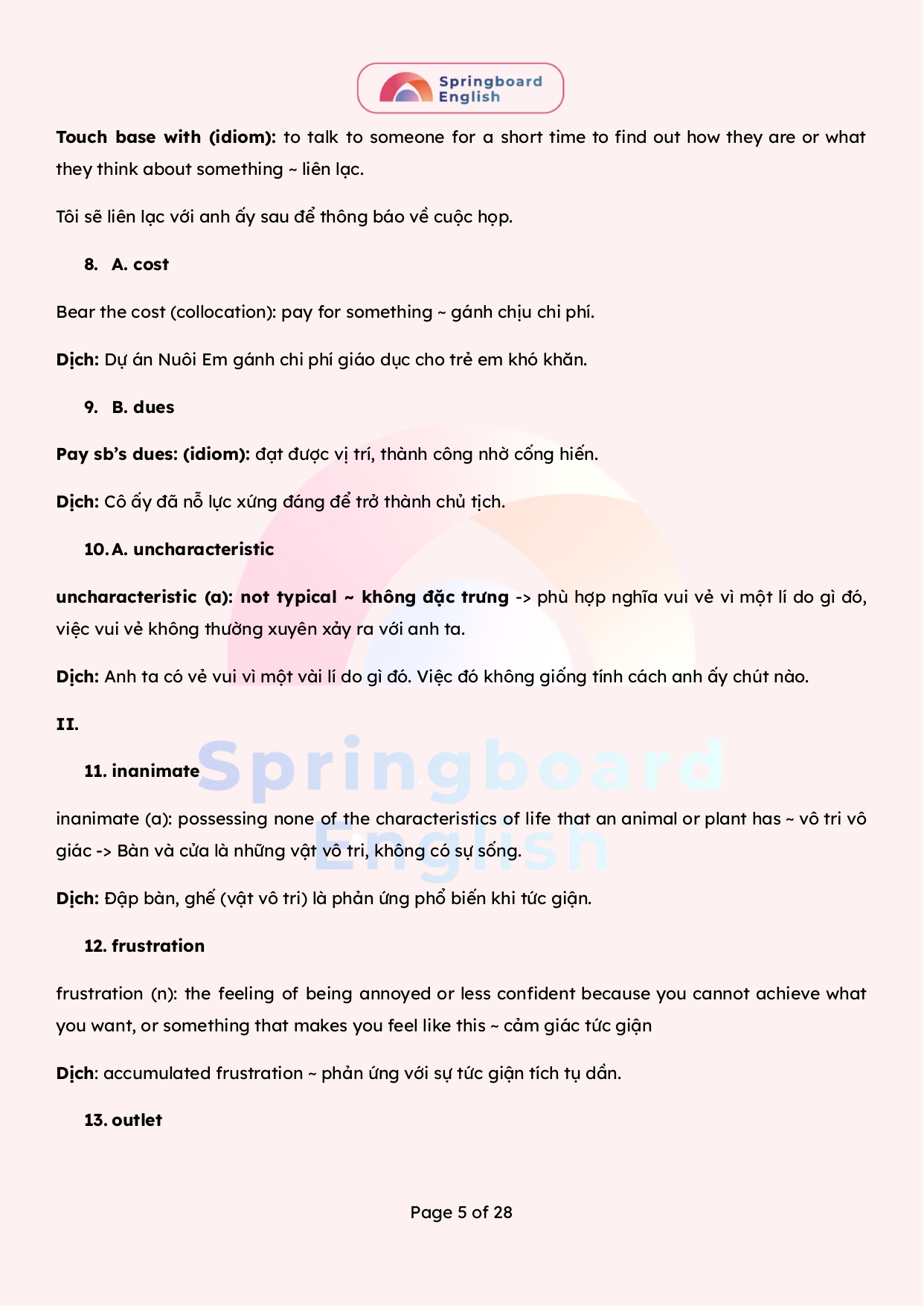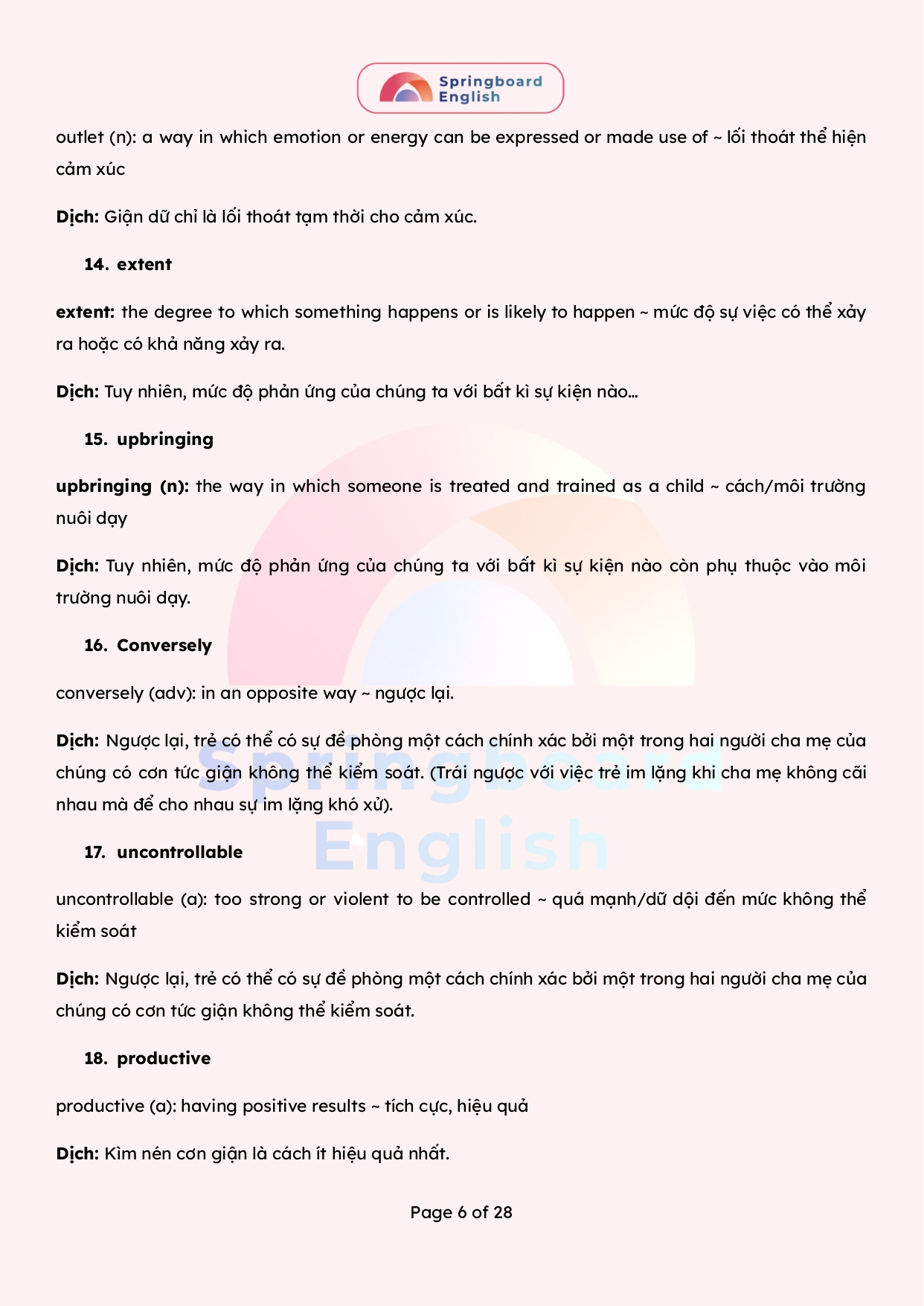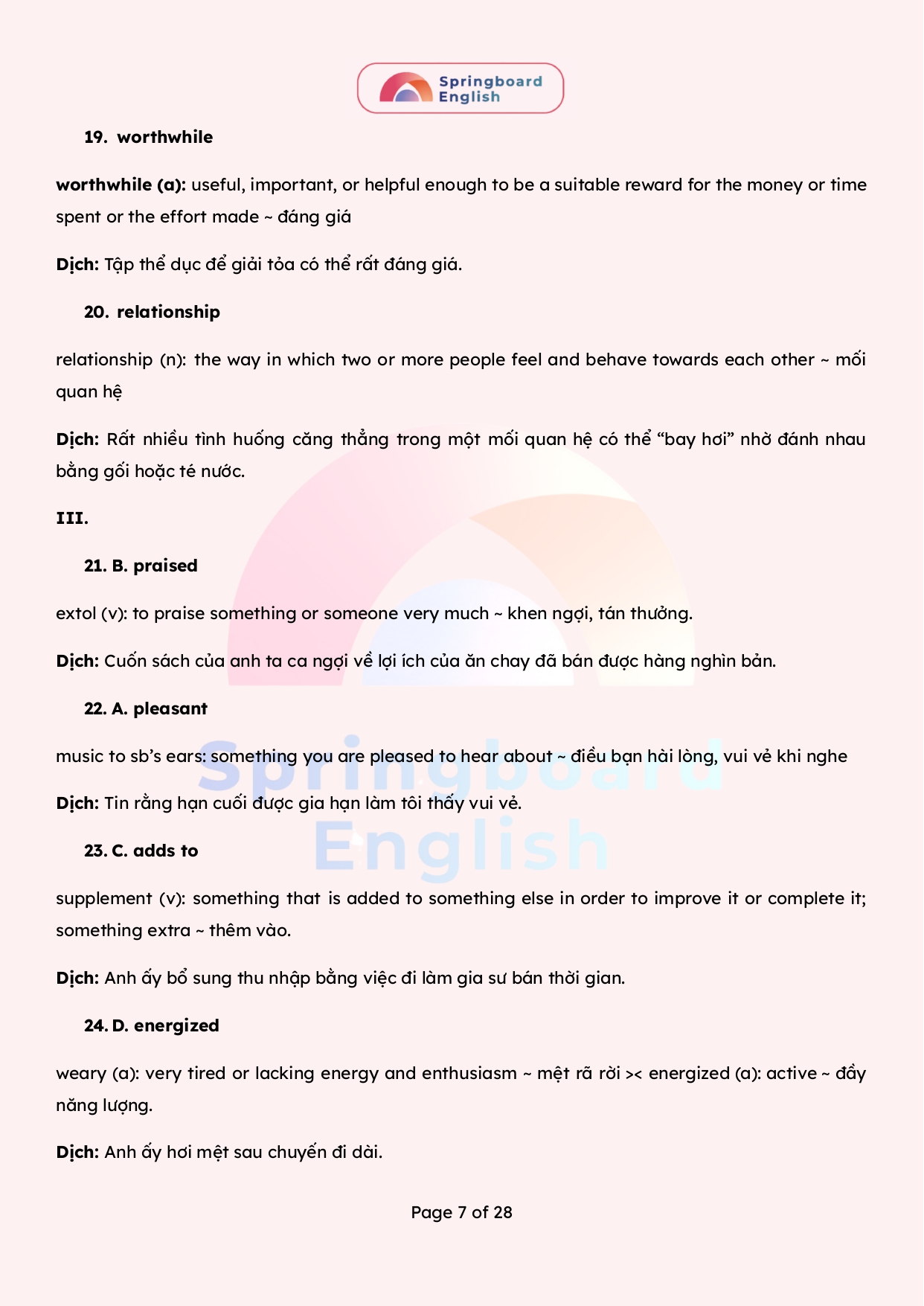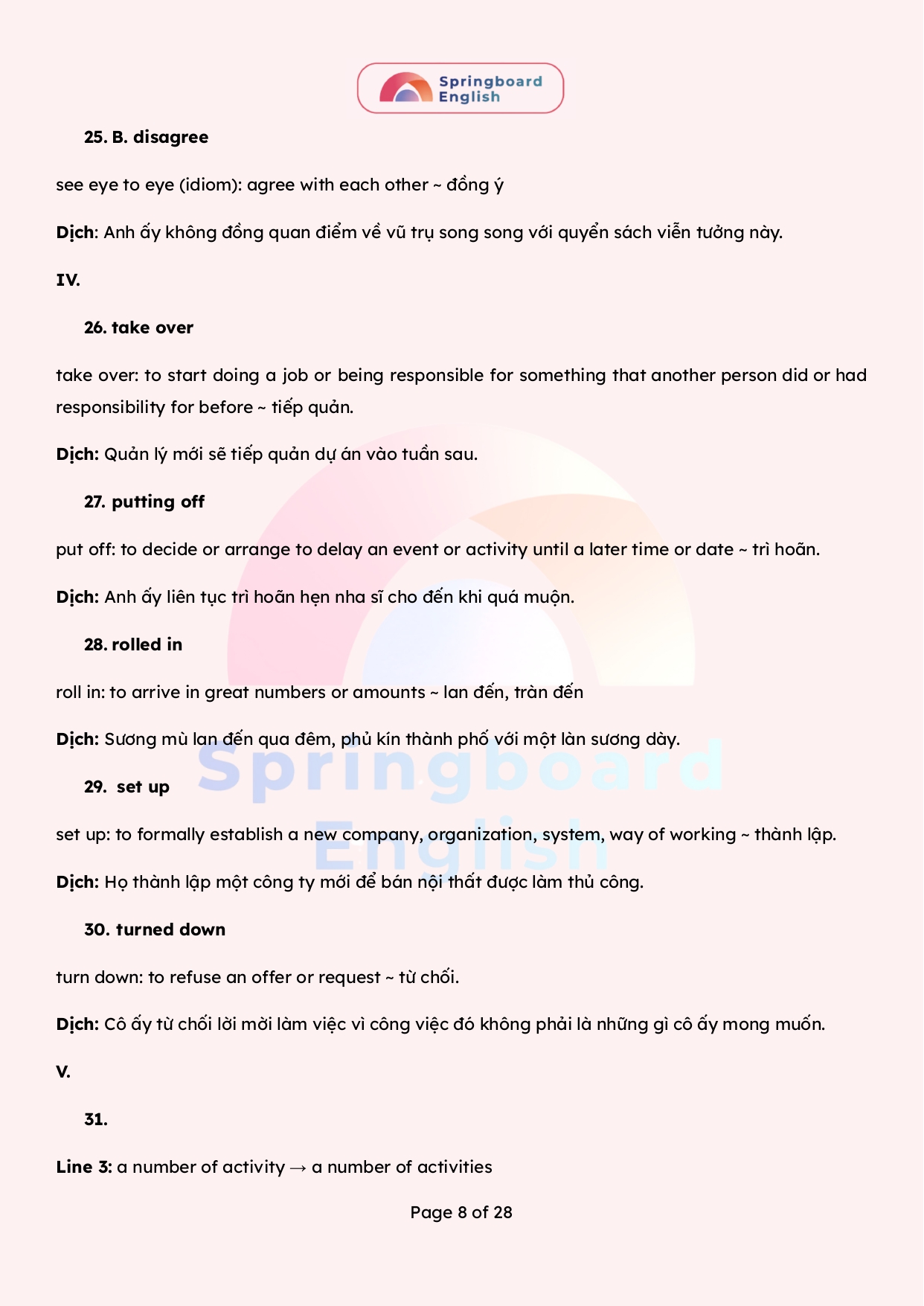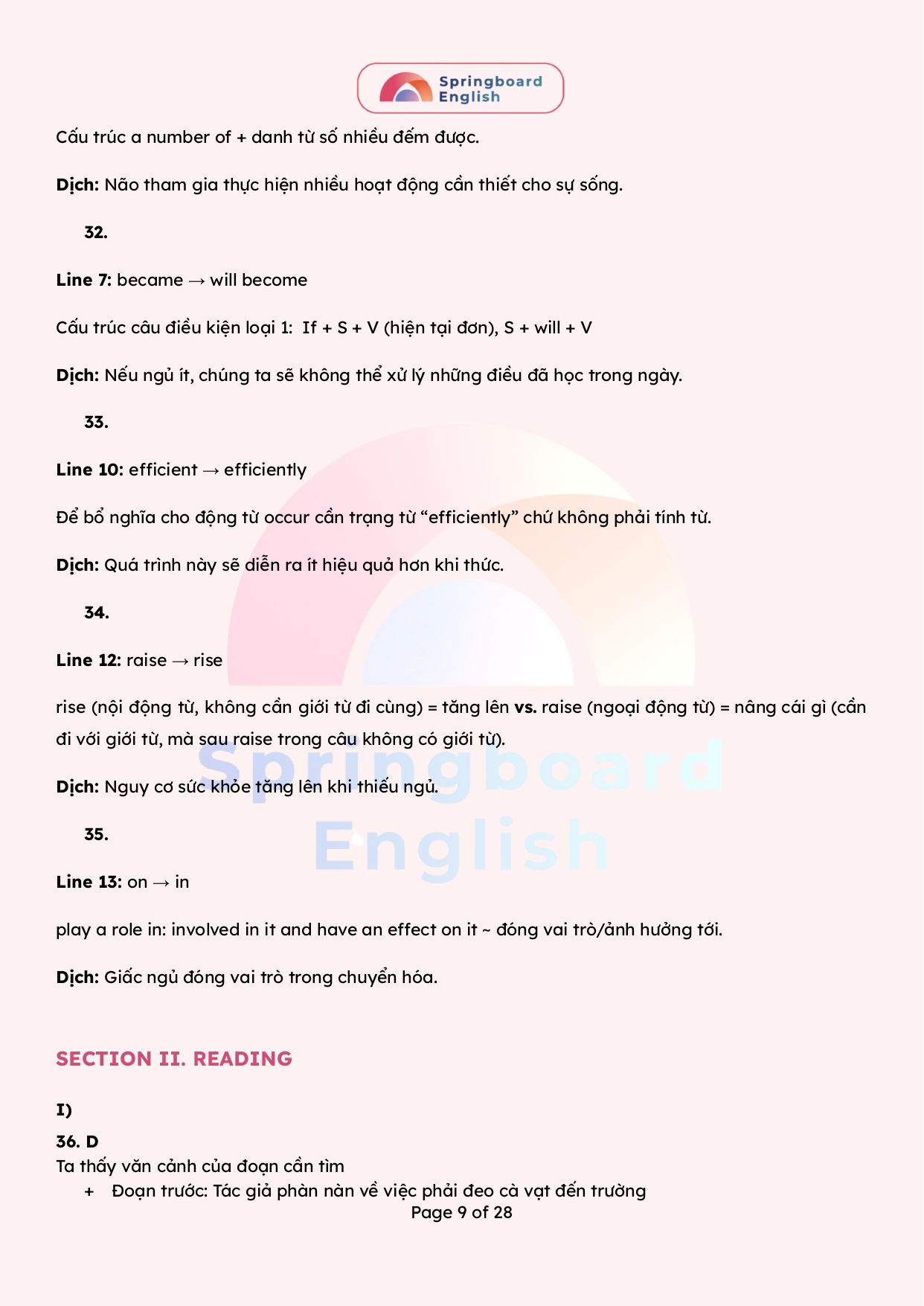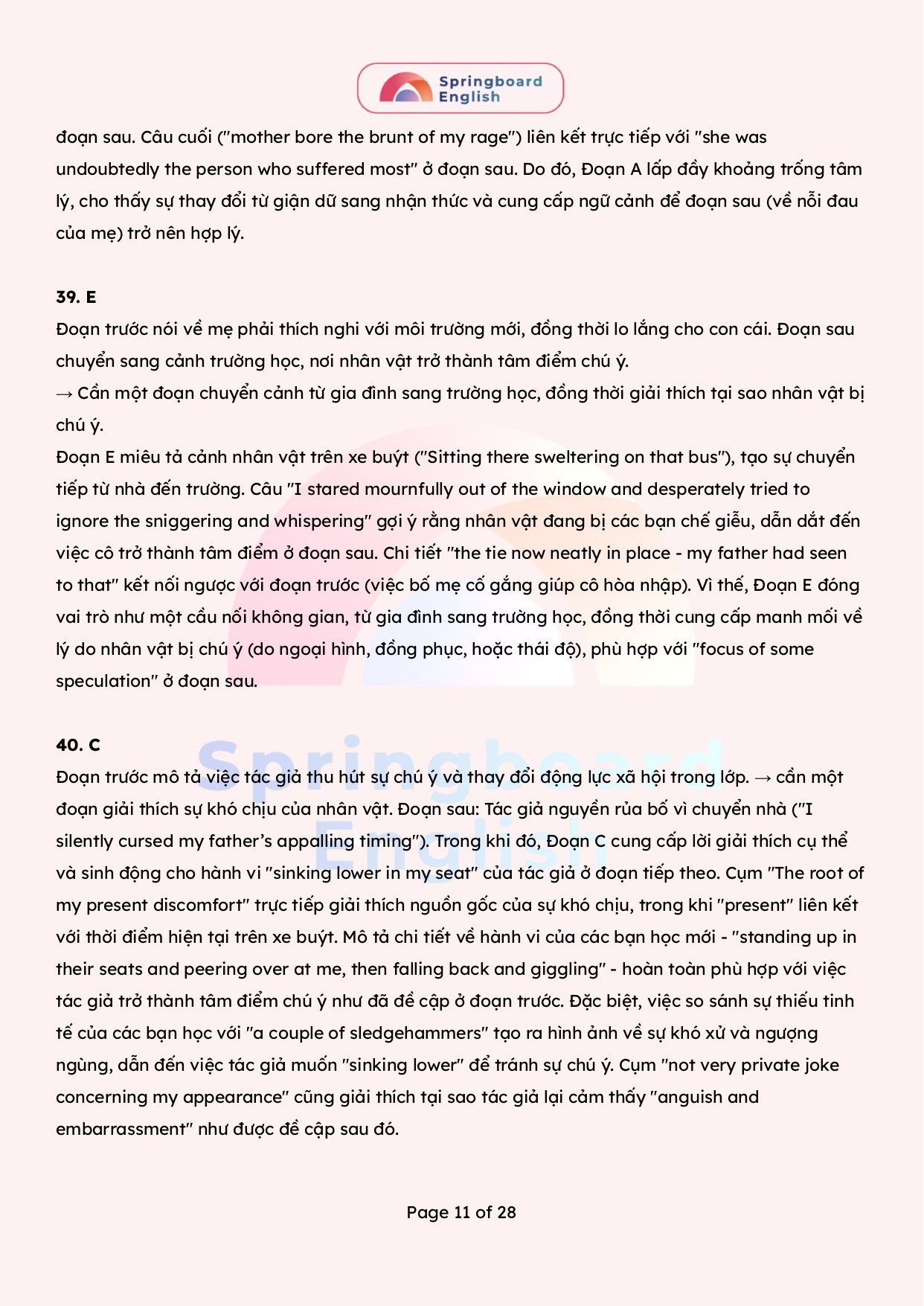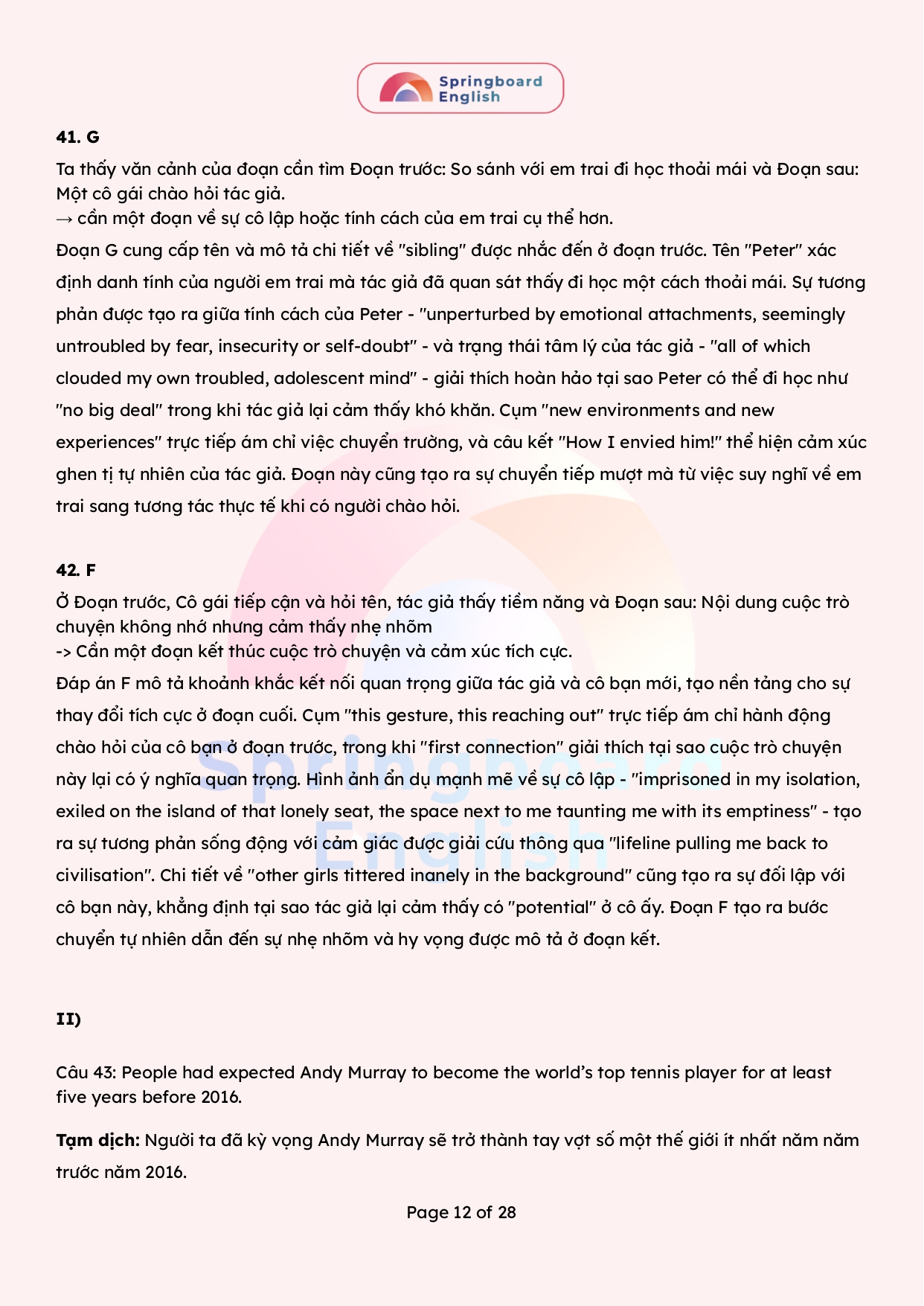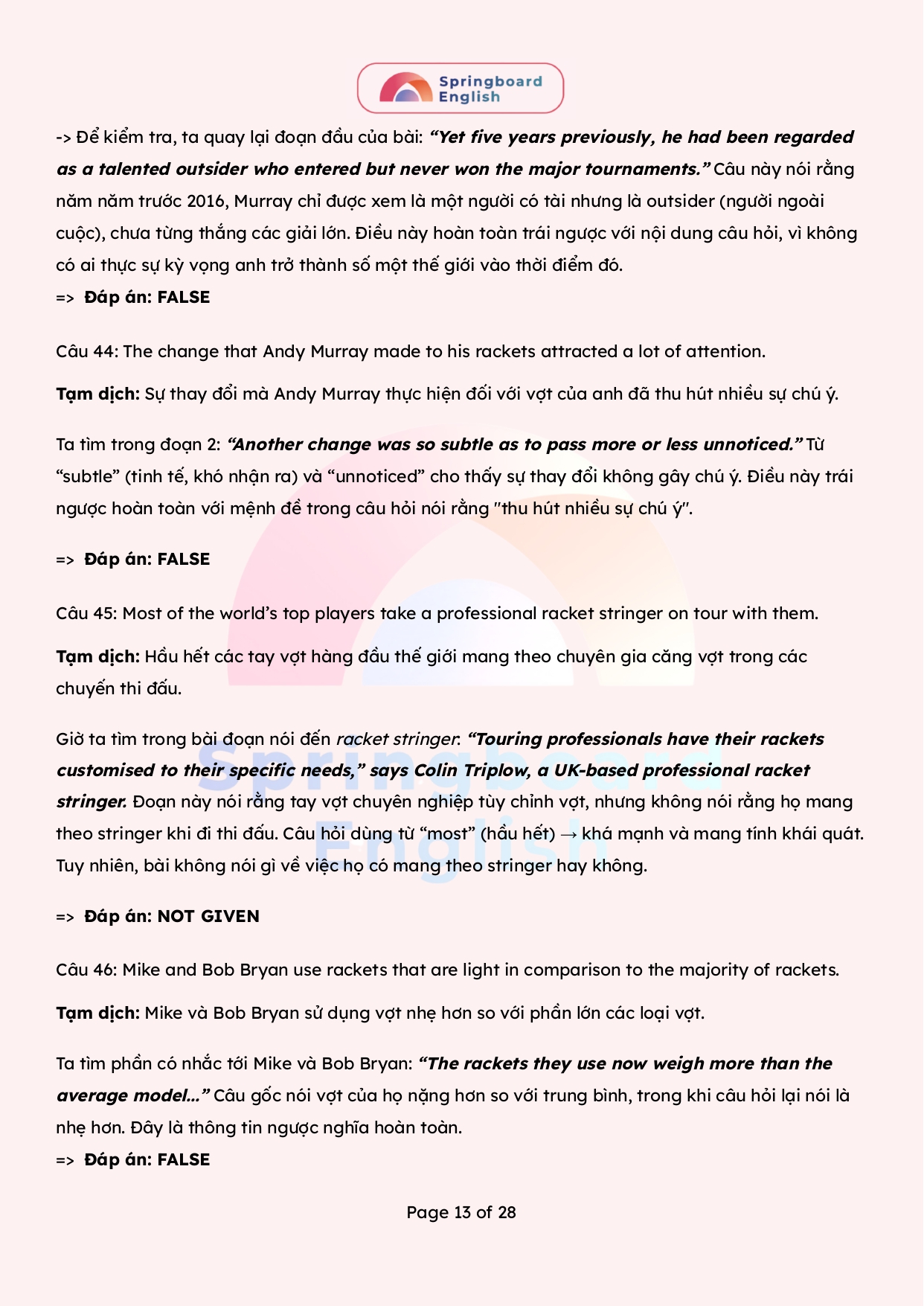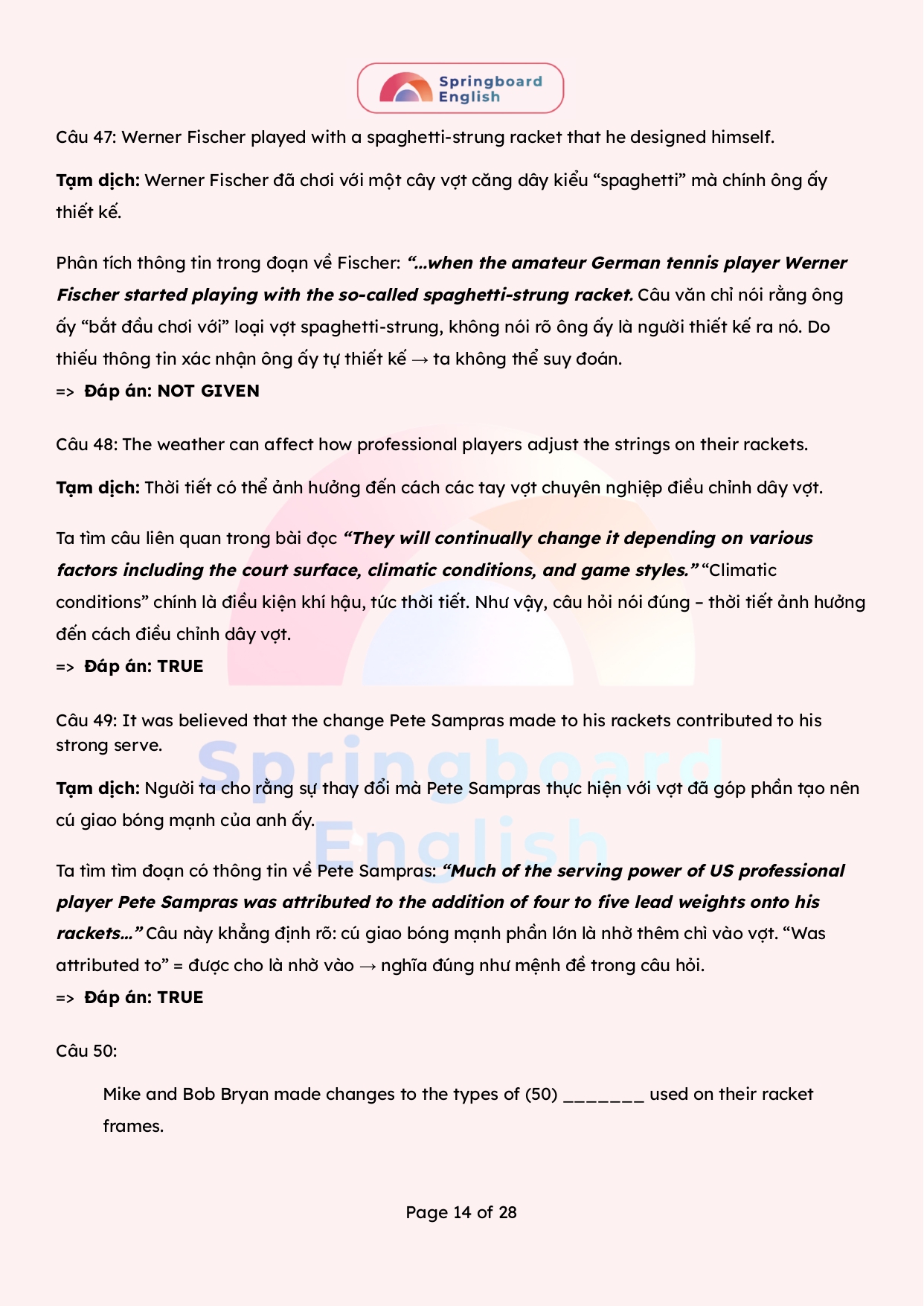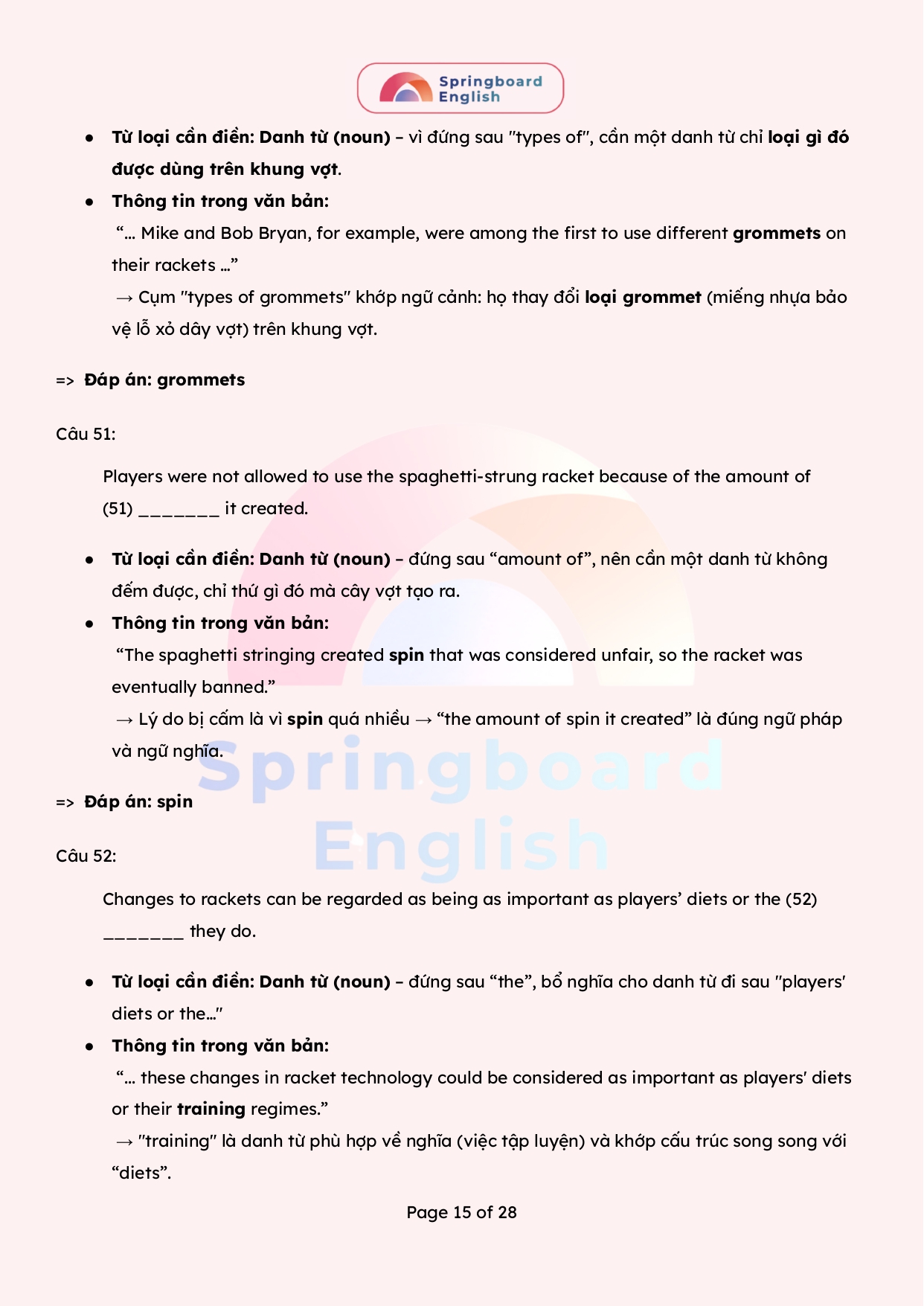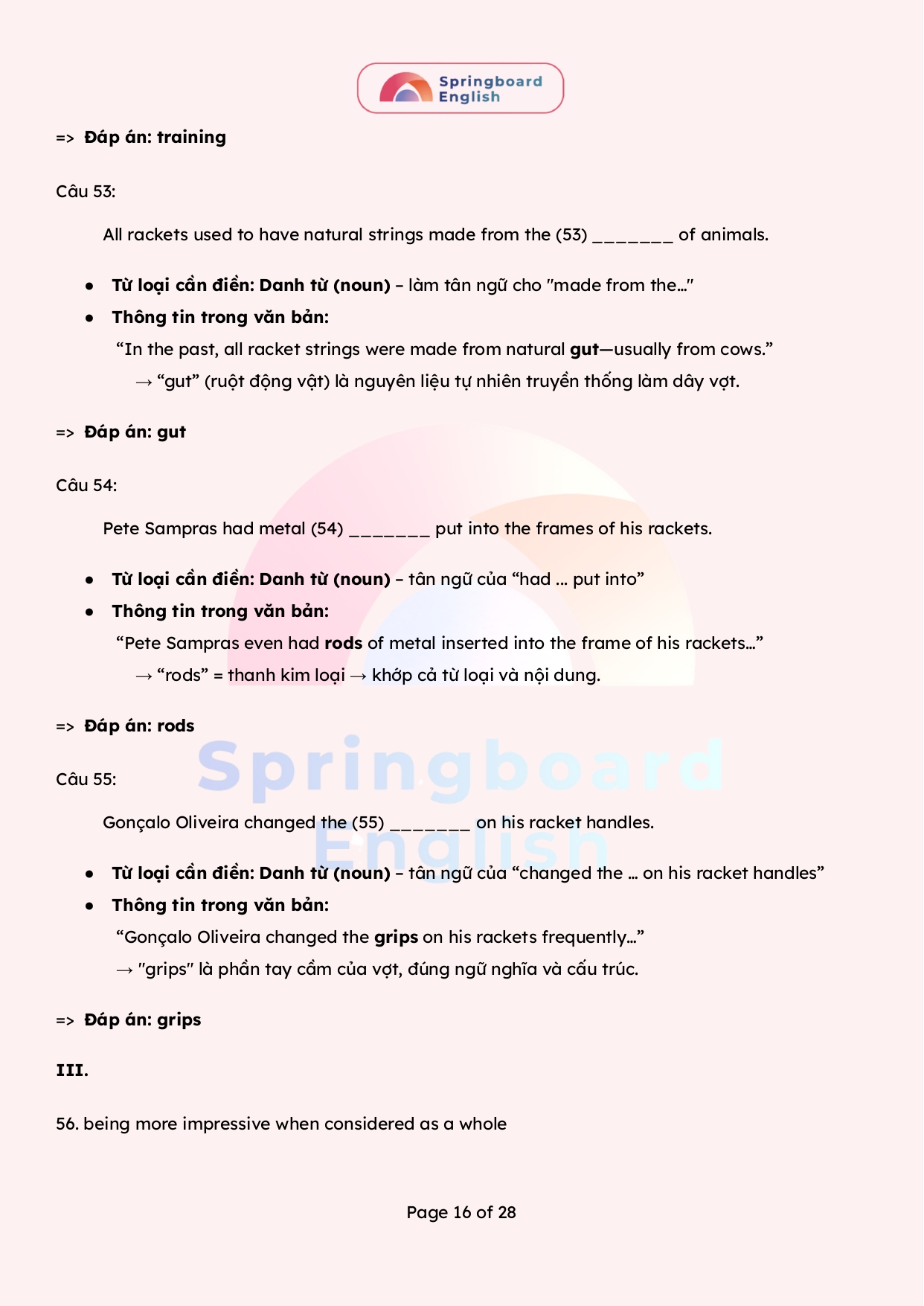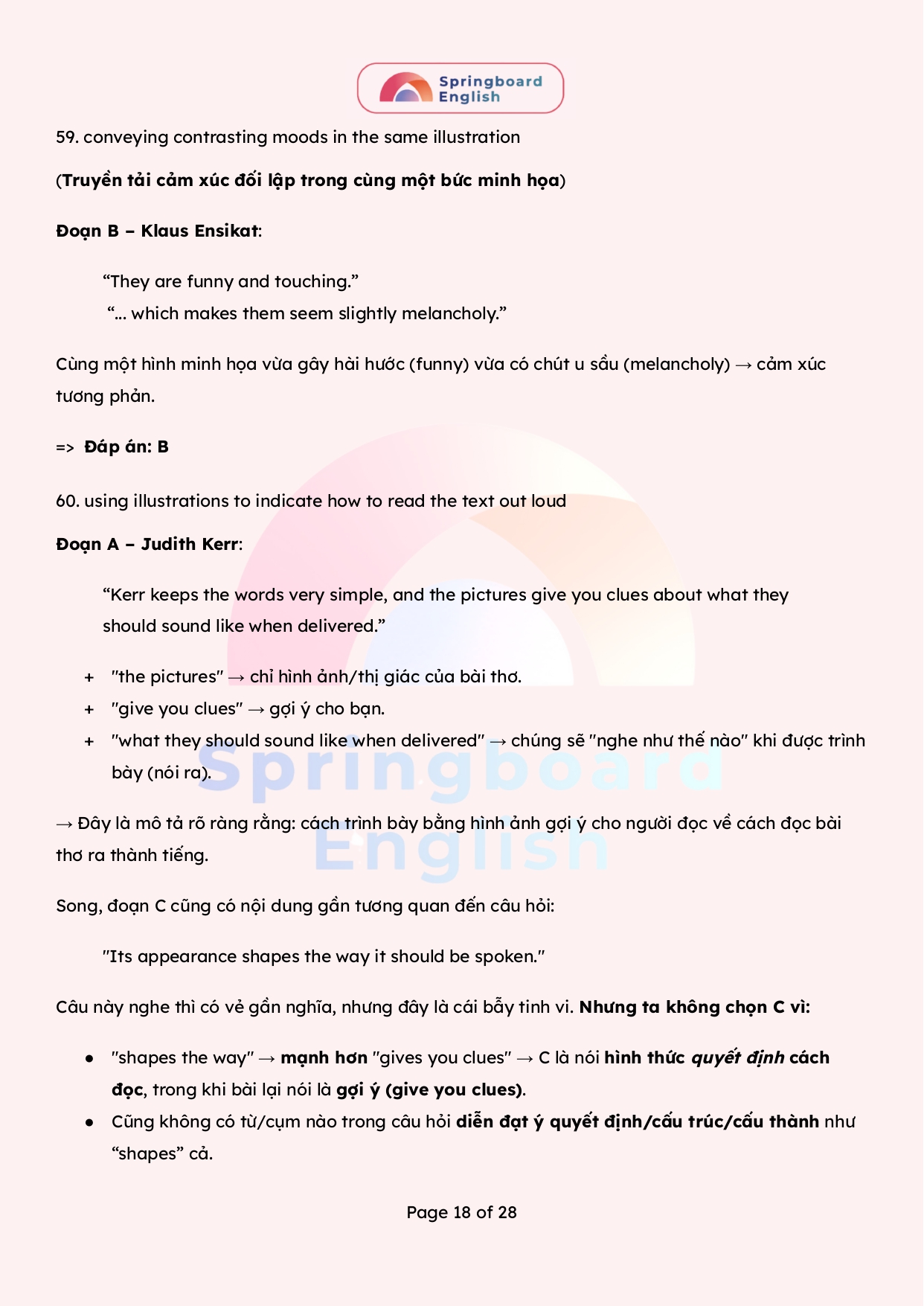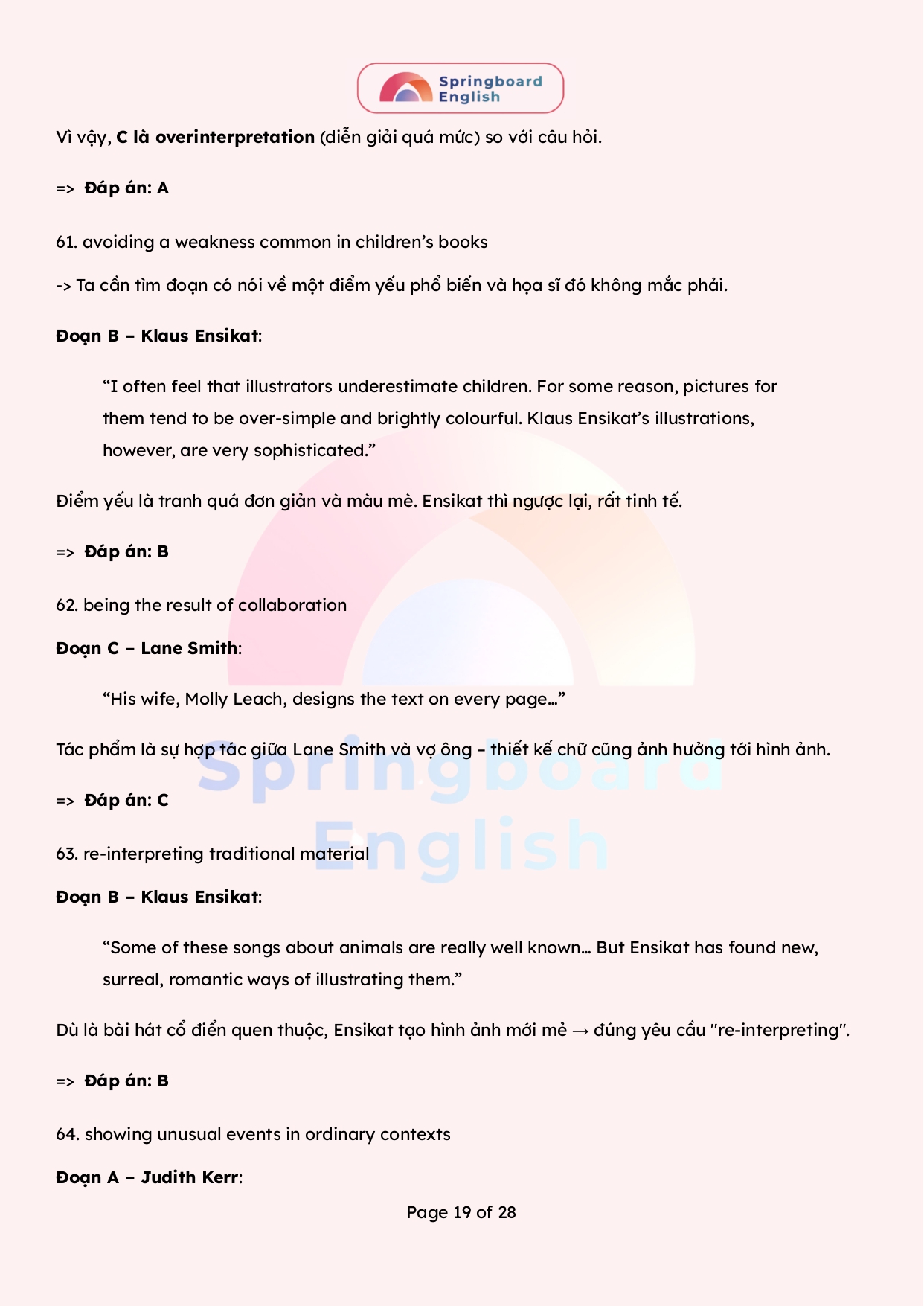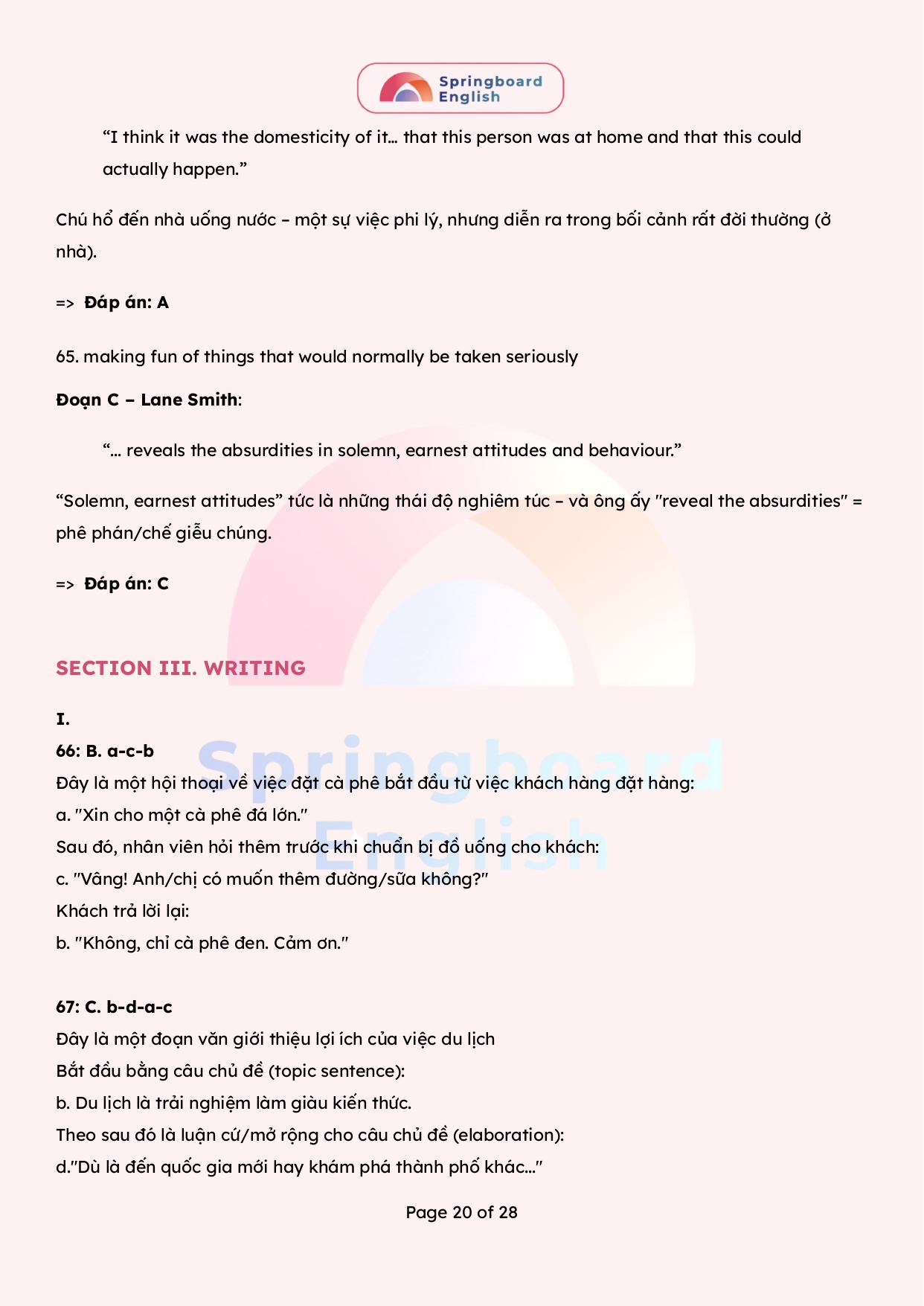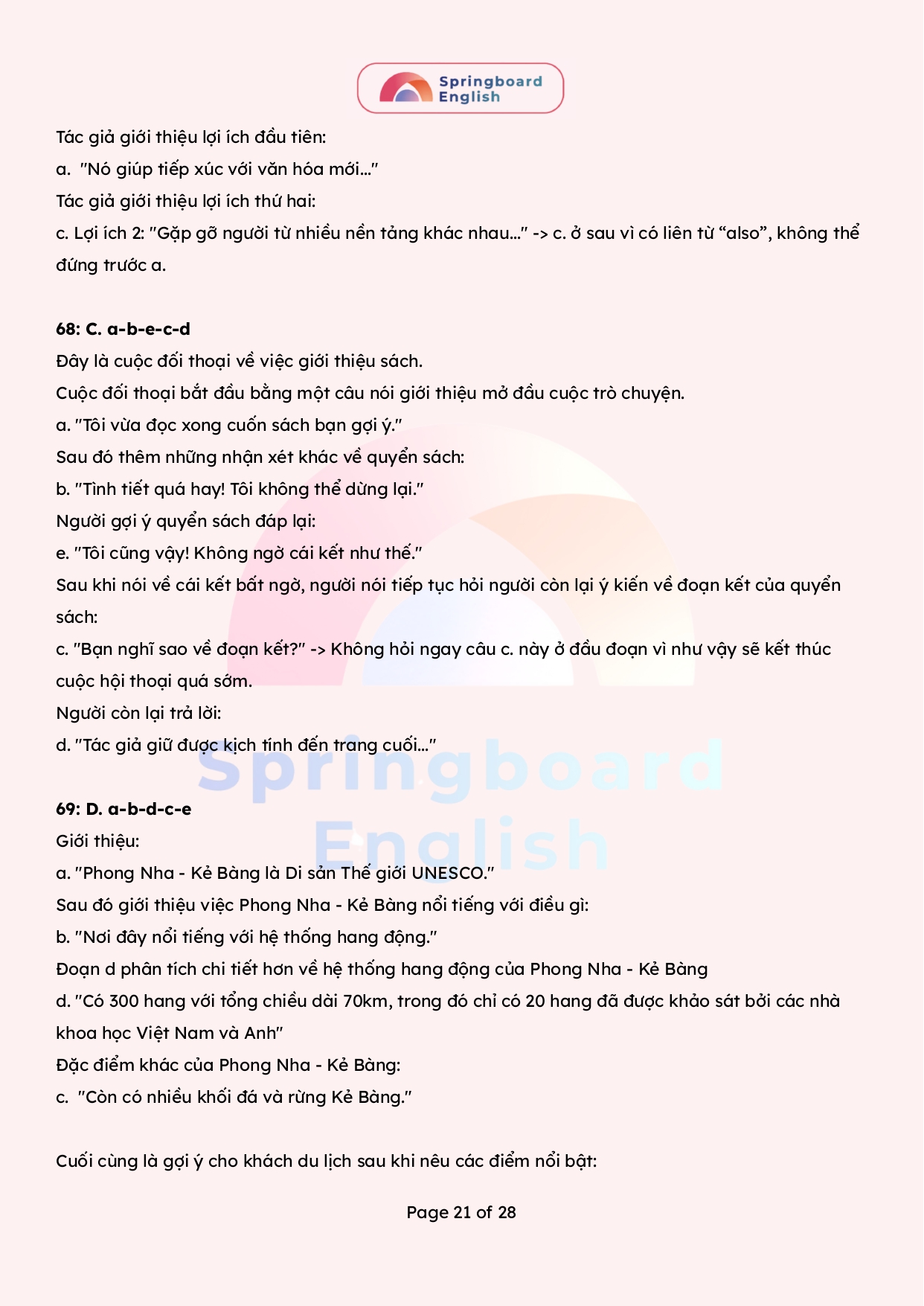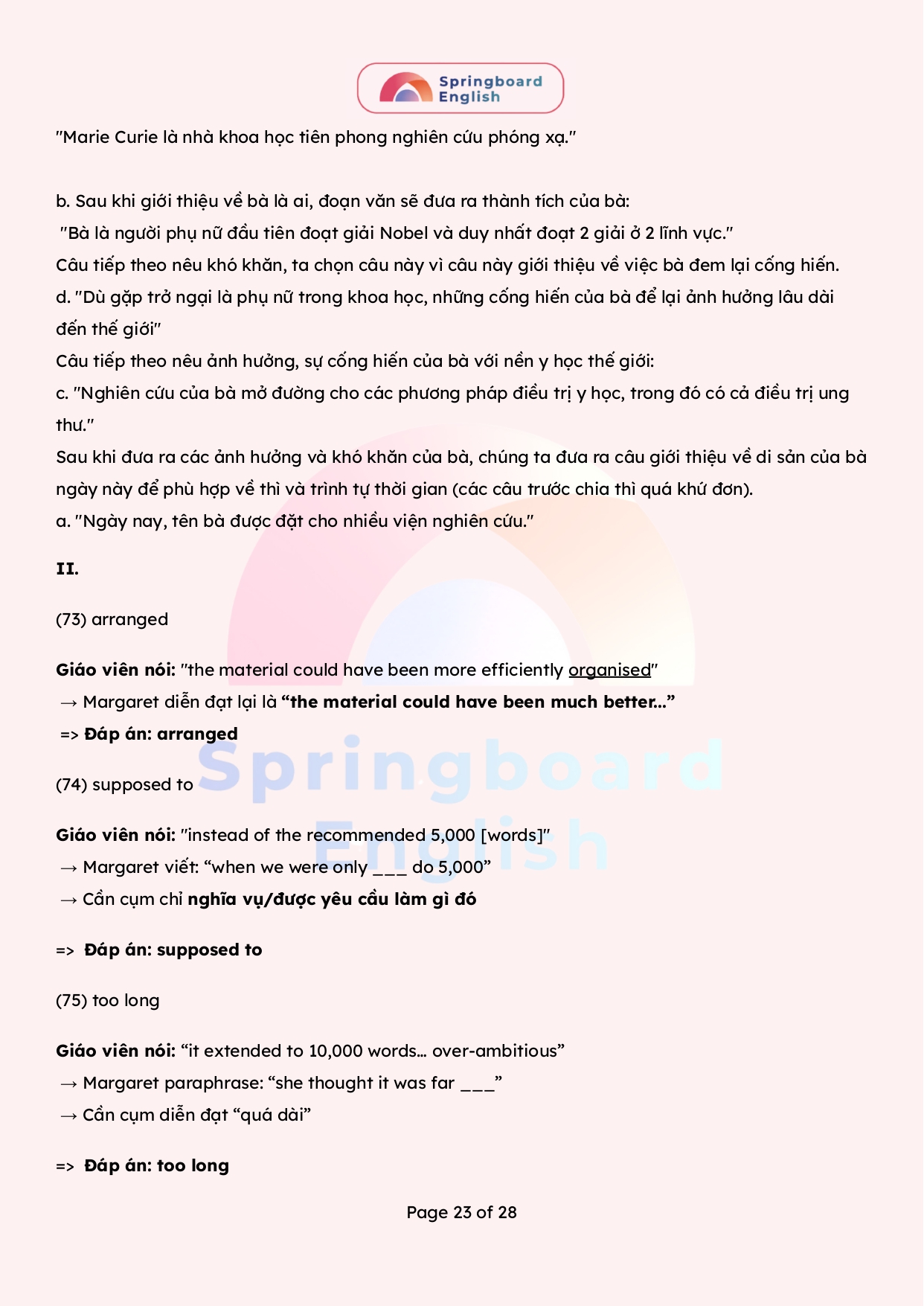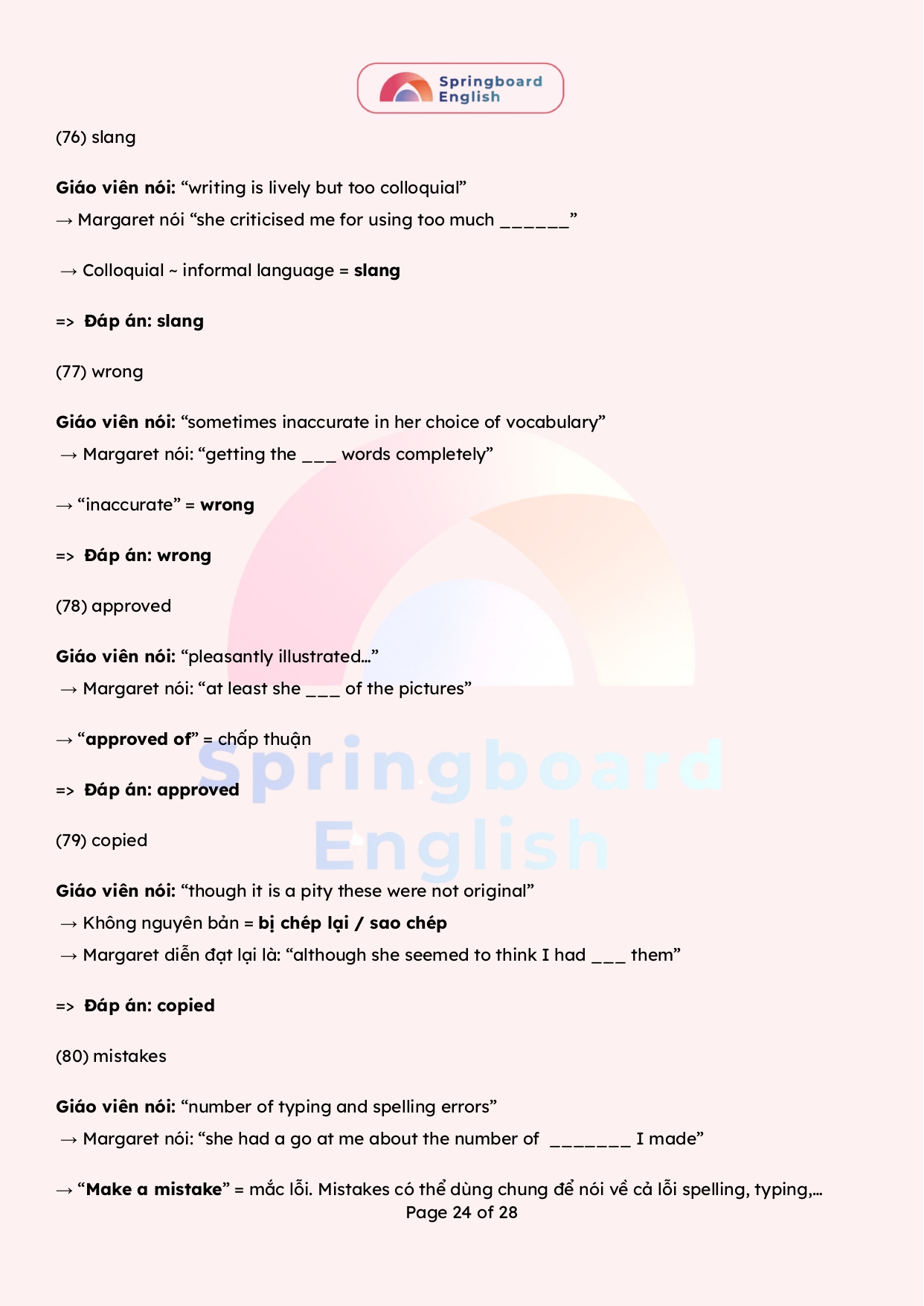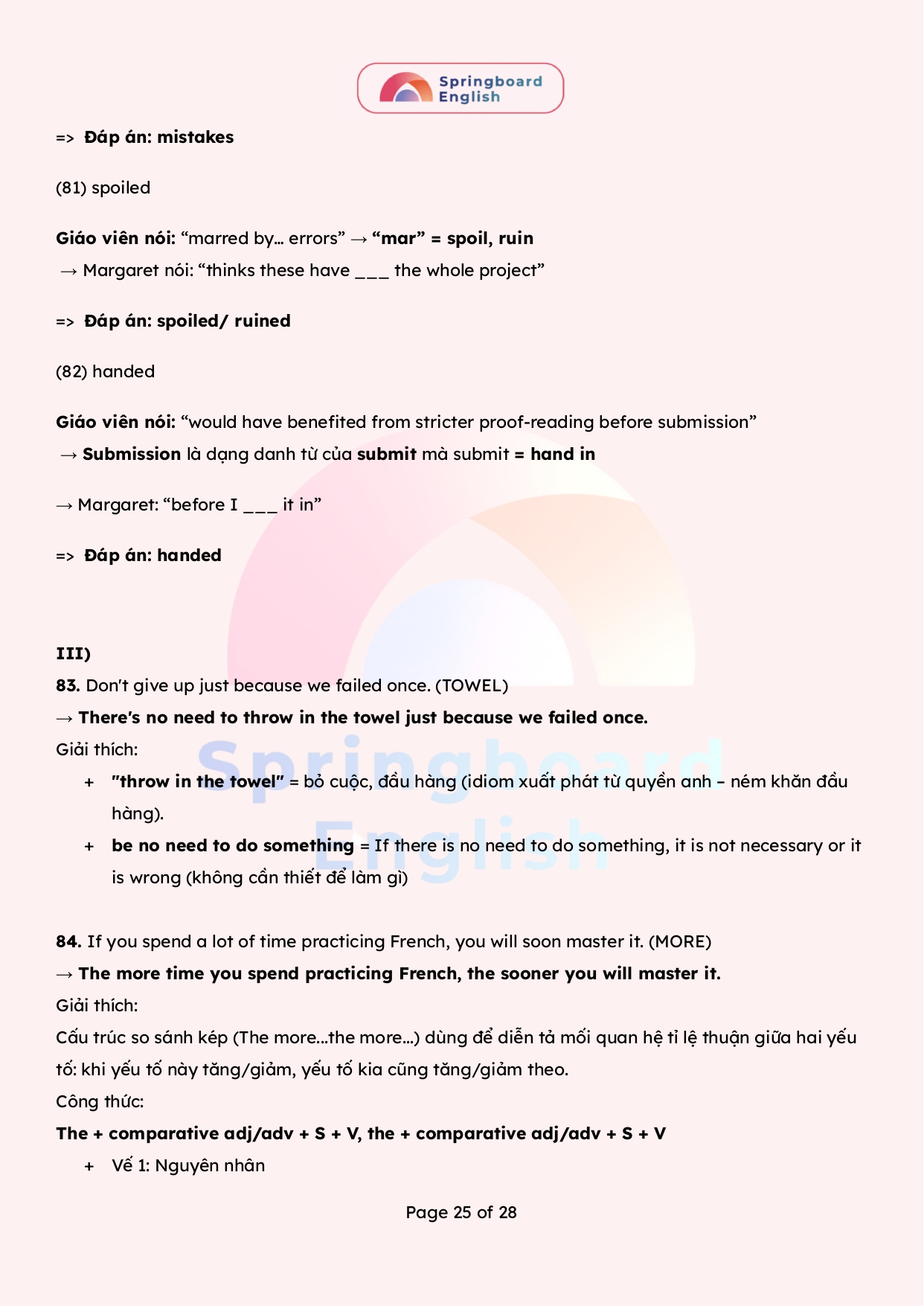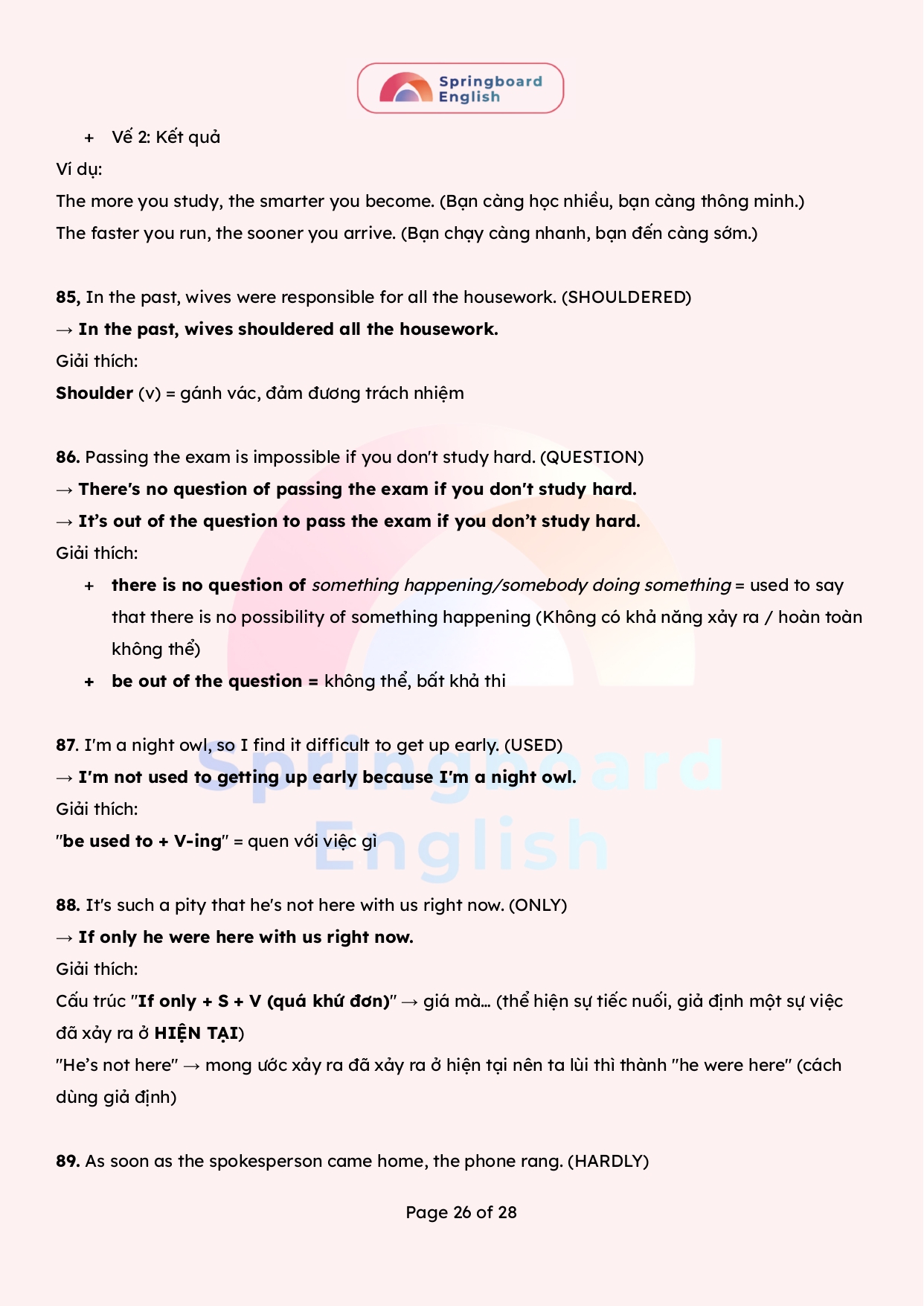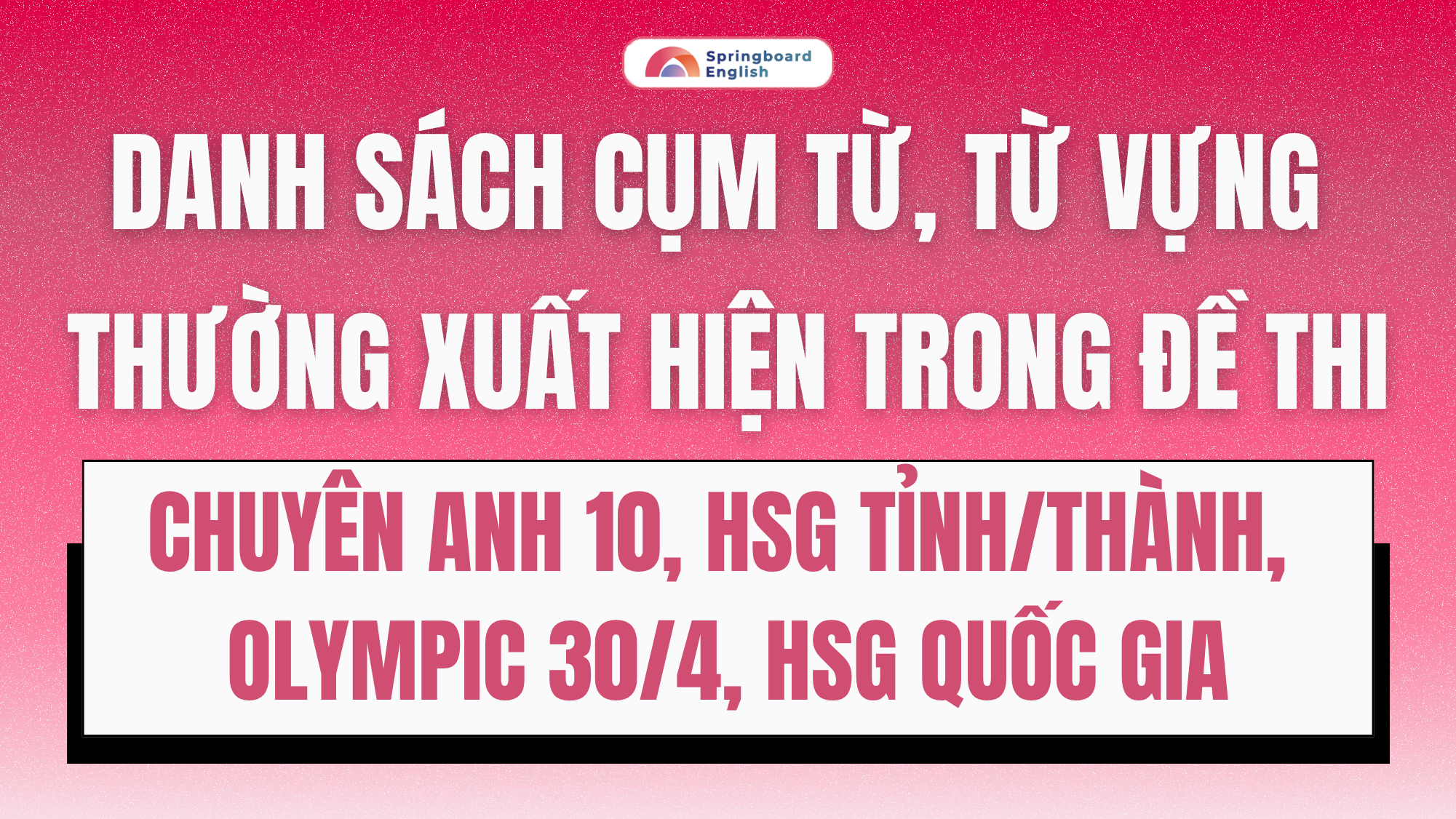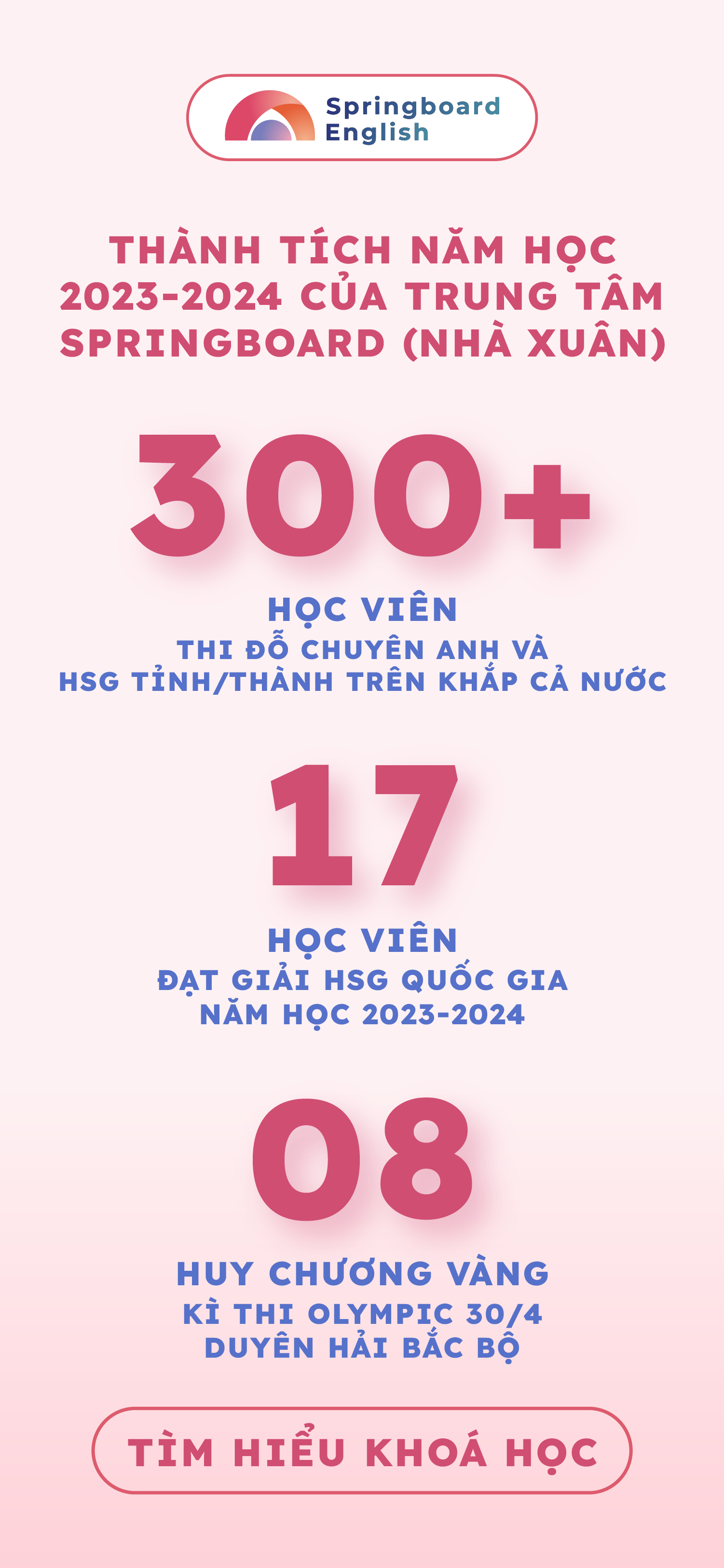Đề thi và Đáp án Olympic liên cụm trường THPT Hà Nội môn tiếng Anh lớp 10, năm học 2024-2025
Đội ngũ anh chị trung tâm Springboard (Nhà Xuân) xin gửi đến các quý phụ huynh, thầy cô, các em học sinh tổng hợp đề thi và đáp án đề thi Olympic liên cụm trường THPT Hà Nội môn tiếng Anh năm 2024-2025 (có đáp án và giải thích chi tiết).
Phần đáp án chi tiết được giới thiệu ở bài viết này là tài liệu được biên soạn trực tiếp bởi đội ngũ chuyên môn Nhà Xuân, đồng thời là bản cập nhật mới nhất trong năm 2025.
Kéo xuống dưới cùng để xem hết đáp án có giải thích chi tiết.
Đề Olympic liên trường THPT Hà Nội môn tiếng Anh 10 năm 2025-2026
|
SỞ GIÁO DỤC VÀ ĐÀO TẠO HÀ NỘI LIÊN CỤM TRƯỜNG THPT |
KỲ THI OLYMPIC DÀNH CHO HỌC SINH LỚP 10, LỚP 11 NĂM HỌC 2024 – 2025 Môn thi: TIẾNG ANH 10 Ngày thi: 15/3/2025 Thời gian làm bài: 120 phút |
|
Họ tên thí sinh: ________________________________________________ Ngày, tháng, năm sinh: _________________________________________ Học sinh trường THPT: ___________________________________________ Điểm dự thi: ___________________________ Số báo danh |
Phách
(do HĐ phách ghi) |
|
|
|
|
Họ tên, chữ ký của cán bộ coi thi số 1
|
Họ tên, chữ ký của cán bộ coi thi số 2
|
|
SỞ GIÁO DỤC VÀ ĐÀO TẠO HÀ NỘI LIÊN CỤM TRƯỜNG THPT ĐỀ CHÍNH THỨC
|
KỲ THI OLYMPIC DÀNH CHO HỌC SINH LỚP 10, LỚP 11 NĂM HỌC 2024 – 2025 Môn thi: TIẾNG ANH 10 Ngày thi: 15/3/2025 Thời gian làm bài: 120 phút (Đề thi gồm 10 trang) |
| Điểm | Cán bộ chấm thi | Phách | ||
|---|---|---|---|---|
| Bằng số | Bằng chữ | Họ và tên | Chữ ký | |
| 1. | ||||
| 2. | ||||
– Thí sinh làm bài trực tiếp vào đề thi và không được sử dụng bất cứ tài liệu nào, kể cả từ điển.
– Cán bộ coi thi không giải thích gì thêm.
PART A. LANGUAGE IN USE (7.0 points)
I. Questions 1-10: Choose the best option A, B, C, or D to indicate the correct answer to each of the following questions. Write your answers in the corresponding numbered boxes provided.
- There are plans to raise global brand __________ through music, fashion and entertainment.
| A. understanding |
| B. awareness |
| C. knowledge |
| D. outlook |
- He’s going to show you the rooms __________.
| A. where are available |
| B. that are available |
| C. there are available |
| D. are available |
- I __________ on my essays yesterday when my body started aching.
| A. had worked |
| B. work |
| C. worked |
| D. was working |
- He suggested __________ the tomatoes before making them into a fine pureé.
| A. having roasted |
| B. to roast |
| C. roasting |
| D. roast |
- She doesn’t like coffee, __________ does she drink tea.
| A. for |
| B. so |
| C. yet |
| D. nor |
- I can’t study whenever my brothers are around. They __________ too much noise.
| A. always make |
| B. are always making |
| C. will always make |
| D. have always made |
- I’ll touch __________ with him later to tell him about the meeting.
| A. point |
| B. base |
| C. connection |
| D. pen |
- The Nuoi Em project helped bear the __________ of education for underprivileged children.
| A. cost |
| B. finance |
| C. money |
| D. price |
- She is incredibly qualified and has paid her __________ to become president.
| A. respects |
| B. dues |
| C. chants |
| D. debts |
- He seems to be happy for some reason. That’s so __________ of him.
| A. uncharacteristic |
| B. asymptomatic |
| C. paranormal |
| D. preternatural |
| 1. | 2. | 3. | 4. | 5. | 6. | 7. | 8. | 9. | 10. |
II. Questions 11-20: Complete the text using the suitable form of the words in capitals. Write your answers in the corresponding numbered boxes provided.
Anger is one of the most commonly-felt emotions, and it can get us into hot water – whilst (0. BOTTLE) bottling things up only makes matters worse. So should you do more than simply gnash your teeth?
Shouting, swearing, and hitting (11. ANIMATE) __________ objects like tables and doors are common responses to accumulated (12. FRUSTRATE) __________. Losing your temper is, however, likely to be little more than a temporary (13. LET) __________ for your feelings and ultimately may lead to humiliation rather than vindication.
So, we learn to hold our emotions in check. The (14. EXTEND) __________ of our reaction to any event, however, will often depend on our (15. BRING) __________. For if parents scream or fall into awkward silences when they are cross, their offspring will probably do the same. (16. CONVERSE) __________, a child may be wary of anger precisely because one of its parents had an (17. CONTROL) __________ temper.
Although there are no hard and fast rules for how best to deal with anger, burying it inside is probably the least (18. PRODUCT) __________ method. Physical release through exercise can be (19. WORTH) __________, however, and many a tense situation in a (20. RELATE) __________ has evaporated thanks to a pillow or water fight. On the other hand, you could get it out of your system by just writing it all down in your diary.
Your answers:| 11. | 12. | 13. | 14. | 15. | |||||
| 16. | 17. | 18. | 19. | 20. |
III. Write your answers in the corresponding numbered boxes provided.
Questions 21-23: Choose the best option A, B, C, or D to indicate the word(s) CLOSEST in meaning to the underlined word(s) in each of the following questions.
- His book, which extolled the benefits of vegetarianism, sold thousands of copies.
| A. considered |
| B. praised |
| C. criticized |
| D. condemned |
- The news that the deadline was extended was music to my ears.
| A. pleasant |
| B. warm |
| C. harsh |
| D. friendly |
- He supplements his income by working part-time as a tutor.
| A. shares with |
| B. deducts from |
| C. adds to |
| D. removes from |
- I think he’s a little weary after his long journey.
| A. exhausted |
| B. apathetic |
| C. pessimistic |
| D. energized |
- He did not see eye to eye with us about the concept of alternate universes for this work of fiction.
| A. concur |
| B. disagree |
| C. hesitate |
| D. decide |
| 21. | 22. | 23. | 24. | 25. |
IV. Questions 26-30: Complete the sentences with the correct form of a verb in A, and a preposition/particle in B. There is one extra preposition that you do not need to use. Write your answers in the corresponding numbered boxes provided.
| A | B |
|---|---|
| put roll set take turn | down in on off over up |
- The new manager will __________ the project next week.
- He kept __________ his dentist appointment until it was too late.
- The fog __________ overnight, covering the city in a thick mist.
- They __________ a new company to sell handmade furniture.
- She __________ the job offer because it wasn’t what she expected.
| 26. | 27. | 28. | 29. | 30. |
V. The passage below contains 5 mistakes. For questions 31-35, UNDERLINE the mistakes and WRITE YOUR CORRECTIONS in the corresponding numbered boxes provided. An example has been done for you.
| Line |
Before the 1950s, most people believed sleep was a passive activity during that the body and brain were dormant. “But it turns out that sleep is a period during which the brain is engaged in a number of activity necessary to life, which are closely linked to quality of life,” says Johns Hopkins sleep expert and neurologist Mark Wu, M.D., Ph.D. If you have ever felt foggy after a poor night’s sleep, it won’t surprise you that sleep significantly impacts brain function. First, a healthy amount of sleep is vital for “brain plasticity,” or the brain’s ability to adapt to input. If we sleep too little, we became unable to process what we’ve learned during the day and we have more trouble remembering it in the future. Researchers also believe that sleep may promote the removal of waste products from brain cells—something that seems to occur less efficient when the brain is awake. Sleep is vital to the rest of the body too. When people don’t get enough sleep, their health risks raise. Symptoms of depression, seizures, high blood pressure and migraines worsen. Immunity is compromised, increasing the likelihood of illness and infection. Sleep also plays a role on metabolism: Even one night of missed sleep can create a prediabetic state in an otherwise healthy person. “There are many important connections between health and sleep,” says Wu. |
| Questions/ Mistake | Line | Correction |
|---|---|---|
| 0. that | 1 | which |
| 31. | ||
| 32. | ||
| 33. | ||
| 34. | ||
| 35. |
PART B. READING (6.0 points)
I. In the passage below, seven paragraphs have been removed. For questions 36-42, read the passage and choose from the paragraphs A–H the one which fits each gap. There is ONE extra paragraph which you do not need to use. Write your answers in the corresponding numbered box provided.
The bus journey seemed interminably long. It was a warm day for March and the atmosphere inside the bus was stifling. My crisp new uniform felt like a straitjacket, the infuriating scarlet tie round my neck threatening to choke me. Ties! We have to wear a tie to school, in this day and age? An outrage, an abomination! My aesthetic senses were affronted.
“Let’s see you do it, then, mother! I mean women wear them all the time, don’t they? So it’s natural that their daughters should wear them to school!” Sarcasm remained my strongest weapon against my patient, care-worn mother. Frustrated, I tore the offensive object from my neck and threw it unceremoniously on the floor. “Just another yoke around our necks to force us to submit to their authority!”
“Come on, dear. It’s not so bad. It’s only a uniform, and you’ll look so smart.” My mother always tried to avert potential head-on collisions between my father and me. “I’m not wearing it! And I’m not going to that crummy school! Why did we have to move? Why couldn’t dad have stayed where he was?” I ranted on, relentless, fighting back angry tears, lamenting the injustice of the situation forced upon me.
With the benefit of hindsight, of course, I realise that she was undoubtedly the person who suffered most from that move. It had been thrust upon her just as much as on us children, and had rocked her world too. She had been happy with her life, her circle of friends, her daily routine. Suddenly, she too found herself in an alien environment, keenly aware not only of her own problems in readjusting, but of those of her offspring as well.
That I was the focus of some speculation was understandable. A new girl starting in the middle of the school year was bound to arouse interest. It boded change of both a demographic nature in the classroom and a geographical one, for where would I sit? And beyond that, a readjustment in the social dynamics of the group, a potential reshuffle in hierarchy.
Sinking lower in my seat, I silently cursed my father’s appalling timing in being relocated, thus bringing upon his daughter anguish and embarrassment for the second time in six months. Was the youngest member of the family suffering the same humiliation? I doubted it. Sporting an equally crisp new uniform, with an equally constrictive tie, but seemingly unaware of it, my sibling had casually strolled off to school that morning as if it were no big deal.
“Hello.” A voice close to my ear broke through my jumbled thoughts and returned me abruptly to the present. It seemed that one of the girls could contain her curiosity no longer. “What’s your name?” I struggled against an urge to be sick, forcing down the lump in my throat, and eyed her suspiciously. Staring at me was an open, fun-loving face, with eyes that sparkled with mischief. It showed potential. At least she was making an effort. I had to give her that.
The content of that first conversation escapes me now. All that remains is the feeling of relief I enjoyed as the knot of fear and embarrassment that had been churning in my stomach gradually dissipated, and even my tie seemed to loosen its stranglehold on my throat. I began to breathe normally again and the prospect of entering a new phase in my life no longer seemed so dark and terrifying.
Missing paragraphs:A The egocentricity of youth often prevents us from perceiving the pain of others. So concerned are we with our own feelings, we believe that no one can be suffering with the same intensity as ourselves. In the emotional turmoil caused by the upheaval of moving house and changing school, of having my world turned upside down, I failed to even consider, let alone comprehend, the pressures upon my parents. Rather, I callously blamed them for the situation, and as usual, mother bore the brunt of my rage.
B My mother thought I was overreacting, as always. “Ever the drama-drawers!” she would say, exasperatedly. “Everything is of major importance when it concerns you. Think of your father for once! It’s not easy for him, either. Don’t be so difficult!”
C The root of my present discomfort lay in the fact that my new classmates were being about as subtle as a couple of sledgehammers, standing up in their seats and peering over at me, then falling back and giggling at some not very private joke concerning my appearance.
D “What kind of establishment are you sending me to this time?” I had berated my mother. It had taken me an age to learn how to do the tie up, standing in front of the mirror, with my father ostensibly showing me how. He soon despaired of my miserable efforts, however, patience not being one of his strong points.
E Sitting there sweltering on that bus, however, the tie now neatly in place – my father had seen to that – understanding and compassion were beyond me as I cursed my misfortune in being forced to change school again. I stared mournfully out of the window and desperately tried to ignore the sniggering and whispering from the seat behind mine.
F While the other girls tittered inanely in the background, we made our first connection. So imprisoned did I feel in my isolation, exiled on the island of that lonely seat, the space next to me taunting me with its emptiness, that this gesture, this reaching out felt like a lifeline pulling me back to civilisation.
G Peter generally went through life with an air of polite aloofness. Unperturbed by emotional attachments, seemingly untroubled by fear, insecurity or self-doubt – all of which clouded my own troubled, adolescent mind – he drifted into new environments and new experiences cushioned by an inherent sense of self-assurance. How I envied him!
H I was full of such proclamations at that age, much to my parents’ consternation. I wore them out with grand statements on independence and free thinking. “Frank and outspoken” were comments frequently made by the teachers at my previous school, euphemisms, no doubt, for “pig-headed and contrary”. My comment on the present state of affairs caused my father’s face to go a dangerous shade of red.
Your answers:| 36. | 37. | 38. | 39. | 40. | 41. | 42. |
II. Read the following passage and do the tasks that follow. Write your answers in the corresponding numbered boxes provided.
In 2016, the British professional tennis player Andy Murray was ranked as the world’s number one. It was an incredible achievement by any standard – made even more remarkable by the fact that he did this during a period considered to be one of the strongest in the sport’s history, competing against the likes of Rafael Nadal, Roger Federer and Novak Djokovic, to name just a few. Yet five years previously, he had been regarded as a talented outsider who entered but never won the major tournaments.
Of the changes that account for this transformation, one was visible and widely publicised: in 2011, Murray invited former number one player Ivan Lendl onto his coaching team – a valuable addition that had a visible impact on the player’s playing style. Another change was so subtle as to pass more or less unnoticed. Like many players, Murray has long preferred a racket that consists of two types of string: one for the mains (verticals) and another for the crosses (horizontals). While he continued to use natural string in the crosses, in 2012 he switched to a synthetic string for the mains. A small change, perhaps, but its importance should not be underestimated.
The modification that Murray made is just one of a number of options available to players looking to tweak their rackets in order to improve their games. “Touring professionals have their rackets customised to their specific needs,” says Colin Triplow, a UK-based professional racket stringer. “It’s a highly important part of performance maximisation.” Consequently, the specific rackets used by the world’s elite are not actually readily available to the public; rather, each racket is individually made to suit the player who uses it. Take the US professional tennis players Mike and Bob Bryan, for example: “We’re very particular with our racket specifications,” they say. “All our rackets are sent from our manufacturer to Tampa, Florida, where our frames go through a thorough customisation process.” They explain how they have adjusted not only racket length, but even experimented with different kinds of paint. The rackets they use now weigh more than the average model and also have a denser string pattern (i.e. more crosses and mains).
The primary reason for these modifications is simple: as the line between winning and losing becomes thinner and thinner, even these slight changes become more and more important. As a result, players and their teams are becoming increasingly creative with the modifications to their rackets as they look to maximise their competitive advantage.
Racket modifications mainly date back to the 1970s, when the amateur German tennis player Werner Fischer started playing with the so-called spaghetti-strung racket. It created a string bed that generated so much topspin that it was quickly banned by the International Tennis Federation. However, within a decade or two, racket modification became a regularity. Today it is, in many ways, an aspect of the game that is equal in significance to nutrition or training.
Modifications can be divided into two categories: those to the string bed and those to the racket frame. The former is far more common than the latter: the choice of the strings and the tension with which they are installed is something that nearly all professional players experiment with. They will continually change it depending on various factors including the court surface, climatic conditions, and game styles. Some will even change it depending on how they feel at the time.
At one time, all tennis rackets were strung with natural gut made from the outer layer of sheep or cow intestines. This all changed in the early 1990s with the development of synthetic strings that were cheaper and more durable. They are made from three materials: nylon (relatively durable and affordable), Kevlar (too stiff to be used alone) or co-polyester (polyester combined with additives that enhance its performance). Even so, many professional players continue to use a “hybrid set-up”, where a combination of both synthetic and natural strings are used.
Of the synthetics, co-polyester is by far the most widely used. It’s a perfect fit for the style of tennis now played, where players tend to battle it out from the back of the court rather than coming to the net. Studies indicate that the average spin from a co-polyester string is 25% greater than that from natural string or other synthetics. In a sense, the development of co-polyester strings has revolutionised the game.
However, many players go beyond these basic adjustments to the strings and make changes to the racket frame itself. For example, much of the serving power of US professional player Pete Sampras was attributed to the addition of four to five lead weights onto his rackets, and today many professionals have the weight adjusted during the manufacturing process.
Other changes to the frame involve the handle. Players have individual preferences for the shape of the handle and some will have the handle of one racket moulded onto the frame of a different racket. Other players make different changes. The professional Portuguese player Gonçalo Oliveira replaced the original grips of his rackets with something thinner because they had previously felt uncomfortable to hold.
Racket customisation and modification have pushed the standards of the game to greater levels that few could have anticipated in the days of natural strings and heavy, wooden frames, and it’s exciting to see what further developments there will be in the future.
Questions 43-49: Do the following statements agree with the information given in the reading passage?In boxes on your answer sheet, write
TRUE if the statement agrees with the information
FALSE if the statement contradicts the information
NOT GIVEN if there is no information on this
- People had expected Andy Murray to become the world’s top tennis player for at least five years before 2016.
- The change that Andy Murray made to his rackets attracted a lot of attention.
- Most of the world’s top players take a professional racket stringer on tour with them.
- Mike and Bob Bryan use rackets that are light in comparison to the majority of rackets.
- Werner Fischer played with a spaghetti-strung racket that he designed himself.
- The weather can affect how professional players adjust the strings on their rackets.
- It was believed that the change Pete Sampras made to his rackets contributed to his strong serve.
Questions 50-55: Complete the notes below. Choose ONE WORD ONLY from the passage for each answer. Write your answers in boxes on your answer sheet.
Mike and Bob Bryan made changes to the types of (50) __________ used on their racket frames. Players were not allowed to use the spaghetti-strung racket because of the amount of (51) __________ it created. Changes to rackets can be regarded as being as important as players’ diets or the (52) __________ they do. All rackets used to have natural strings made from the (53) __________ of animals. Pete Sampras had metal (54) __________ put into the frames of his rackets. Gonçalo Oliveira changed the (55) __________ on his racket handles.
Your answers:| 43. | 44. | 45. | 46. | 47. | |||||
| 48. | 49. | 50. | 51. | 52. | |||||
| 53. | 54. | 55. |
III. You are going to read an article in which an illustrator of children’s books talks about other illustrators’ work. For questions 56 – 65, choose from the sections (A – D). The sections may be chosen more than once. Write your answers in the corresponding numbered boxes provided.
Which illustrator’s work is described as
- being more impressive when considered as a whole?
- inspiring experimentation?
- becoming simpler over time?
- conveying contrasting moods in the same illustration?
- using illustrations to indicate how to read the text out loud?
- avoiding a weakness common in children’s books?
- being the result of collaboration?
- re-interpreting traditional material?
- showing unusual events in ordinary contexts?
- making fun of things that would normally be taken seriously?
Illustrator Hannah Roberts talks about the work of other children’s book illustrators
A Judith Kerr
I loved The Tiger Who Came to Tea by Judith Kerr when I was a child. I remember being obsessed with the scene where the tiger came and drank all the water in the tap. I think it was the domesticity of it, that this person was at home and that this could actually happen. Nothing much happens, in fact, but it’s still magical. Kerr keeps the words very simple, and the pictures give you clues about what they should sound like when delivered. In her Mog books, you can look at the cat’s face to see how shocking or dramatic the action is. He is just a funny cat, with an expressive face. If you mention Mog or The Tiger Who Came to Tea to someone under the age of 40, they usually smile, which is the instinctive reaction a children’s book should provoke. I can think of illustrators who are technically better and books with richer textual content, but, with Kerr, there’s something about the way the entire package fits together that’s wonderful.
B Klaus Ensikat
I often feel that illustrators underestimate children. For some reason, pictures for them tend to be over-simple and brightly colourful. Klaus Ensikat’s illustrations, however, are very sophisticated. His drawing is absolutely exquisite, a little like engraving, and he covers large areas with fine, precise lines that give life to shadows, furniture, forests, clothes and soft fur. Those drawings are then washed over with fine watercolour paint, which makes them seem slightly melancholy. At the same time, they are funny and touching. My favourite of his books is a collection of old German children’s songs called Jeder nach seiner Art (To Each Their Own). The texts are handwritten in beautiful old-fashioned calligraphy, and next to them are tiny, perfect black-and-white drawings. Some of these songs about animals are really well known in the German-speaking world, and a less brilliant illustrator would render them visually as familiar, cheerful and superficial. But Ensikat has found new, surreal, romantic ways of illustrating them. I keep buying his books in the (so far vain) hope that I will discover his secret.
C Lane Smith
I first saw Lane Smith’s work when I was a young illustrator. His book The Stinky Cheese Man and other Fairly Stupid Tales was lively and irreverent. It had a fabulous sense of colour, and what especially appealed was the texture: I have always loved layered, dappled surfaces, and Lane Smith uses collage to create a wonderful, grungy feel. His artwork is innovative, and often reveals the absurdities in solemn, earnest attitudes and behaviour. His characters are striking and often staged on a flat plane like a theatre set. The overall design also marks out a Lane Smith look. His wife, Molly Leach, designs the text on every page and, ingeniously, its appearance shapes the way it should be spoken. Lately, Smith’s approach has been more minimal. In his recent book, Grandpa Green, the colour is muted, with drawn outlines against white backgrounds. The truth is that his art has never stood still.
D John Burningham
I recently came across a book by John Burningham, Mr Grumpy’s Outing, that instantly transported me back to my childhood. He can create the sense of a scorching hot summer’s day simply by using a few yellow dots and dashes to represent the sun; you can really feel the heat. His work looks almost haphazard, with smudges, scratches and splodges. But it doesn’t matter whether they were intended or just happy mistakes; they all come together in these wonderful, atmospheric images. You get the impression that he draws with whatever comes to hand. He builds the images with glorious blocks of colour which he then works on with cross-hatching and scribbles of pencil and crayon. The results are full of movement and life. More recently, he has used photography, worked over with paint and mixed with drawn characters, to make rich landscapes. I love the humour he gets into these pictures, the expressions he conjures up with just a few lines. I’ve learned to take risks myself from looking at his books; they leave me feeling less afraid of that blank expanse of white paper.
Your answers:| 56. | 57. | 58. | 59. | 60. | |||||
| 61. | 62. | 63. | 64. | 65. |
PART C. WRITING (7.0 points)
I. Questions 66-72: Choose the letter A, B, C, or D to indicate the best arrangement of utterances or sentences to make a meaningful exchange or text in each of the following questions. Write your answers in the corresponding numbered boxes provided.
-
a. Hi, can I get a large iced coffee, please?
b. No, just black. That’s all, thank you.
c. Of course! Would you like any sugar or milk with that?
| A. a-b-c |
| B. a-c-b |
| C. b-a-c |
| D. c-a-b |
-
a. It provides an opportunity to explore new cultures and broaden perspectives.
b. Traveling is one of the most enriching experiences in life.
c. Meeting people from different backgrounds can also enhance one’s understanding of the world.
d. Whether visiting a new country or exploring a different city, travel offers countless benefits.
| A. b-a-d-c |
| B. a-b-c-d |
| C. b-d-a-c |
| D. d-b-a-c |
-
a. I just finished reading that book you recommended.
b. The plot twists were incredible. I couldn’t put it down.
c. What did you think of the ending?
d. The author did a great job keeping the suspense until the last chapter.
e. Me neither! I didn’t expect that final twist at all.
| A. a-b-c-e-d |
| B. a-c-b-d-e |
| C. a-b-e-c-d |
| D. a-c-b-e-d |
-
a. Phong Nha – Ke Bang National Park is a UNESCO World Heritage Site in Viet Nam.
b. The park is famous for its cave systems.
c. The park contains many fascinating rock formations and Ke Bang Forest as well.
d. It has 300 caves with a total length of about 70 km, of which only 20 have been surveyed by Vietnamese and British scientists.
e. Travelers should take a boat ride through underground rivers to experience nature and enjoy fresh air.
| A. a-b-c-d-e |
| B. a-c-d-b-e |
| C. a-d-b-c-e |
| D. a-b-d-c-e |
-
a. I’d prefer an exchange if you have a different size.
b. Thank you! Would you like a refund or an exchange?
c. I’d like to return this sweater. It doesn’t fit me properly.
d. Yes, here it is. I bought it last week.
e. Do you have the receipt with you?
| A. a-b-c-d-e |
| B. a-d-b-c-e |
| C. c-e-d-b-a |
| D. c-b-d-e-a |
-
a. Many students find learning a new language challenging.
b. One useful method is practicing with native speakers, which improves pronunciation and fluency.
c. However, using effective strategies can make the process easier and more enjoyable.
d. Additionally, watching movies or reading books in the target language helps expand vocabulary.
e. With regular practice and motivation, anyone can become proficient in a new language.
| A. a-c-b-d-e |
| B. a-d-b-c-e |
| C. a-e-b-c-d |
| D. a-b-d-c-e |
-
a. Today, her legacy lives on through the institutions and research centers named in her honor.
b. She was the first woman to win a Nobel Prize and remains the only person to win in two different scientific fields.
c. Her discoveries paved the way for advancements in medical treatments, including cancer therapy.
d. Despite facing challenges as a woman in science, her contributions left a lasting impact on the world.
e. Marie Curie was a pioneering scientist known for her research on radioactivity.
| A. e-b-c-a-d |
| B. e-b-d-c-a |
| C. b-d-c-e-a |
| D. e-a-b-d-c |
| 66. | 67. | 68. | 69. | 70. | 71. | 72. |
II. Questions 73-82: Read the following teacher’s comments on a school project. Use the information in it to complete the numbered gaps in the informal letter from the student who did the project. The words which you need DO NOT OCCUR in the teacher’s comments. Use NO MORE THAN TWO WORDS for each gap. Write your answers in the corresponding numbered boxes provided.
The exercise begins with an example (0).
TEACHER’S COMMENTS
CONTENT: Margaret’s report on “Language Development in Two-Year-Old Twins” represents a year’s painstaking work. The case study shows various strengths, particularly acute observation but the material could have been more efficiently organised. The paper was perhaps over-ambitious since it extended to 10,000 words instead of the recommended 5,000.
STYLE: The writing is lively but too colloquial for this kind of text. Margaret is also sometimes inaccurate in her choice of vocabulary, with unfortunate results.
PRESENTATION: The project is pleasantly illustrated with photographs and some useful charts, though it is a pity these were not original. The work is marred by a number of typing and spelling errors and would have benefited from stricter proof-reading before submission.
INFORMAL LETTER
Dear Annie,
How are you getting on with your language project? As you know, it took me a year to complete mine. And now I’ve just got a copy of the comments the teacher made on it, and she obviously thinks it’s a bit of a disaster!
She seems quite (0) satisfied with my observations, but said the material could have been much better (73) __________. I think that I probably aimed too high because I went up to 10,000 words when we were only (74) __________ do 5,000. She certainly thought it was far (75) __________. Then she criticised me for using too much (76) __________ and sometimes getting the (77) __________ words completely!
At least she (78) __________ of the pictures I spent hours preparing (although she seemed to think I had (79) __________ them!). But then she had a go at me about the number of (80) __________ I made, and she obviously thinks these have (81) __________ the whole project. I suppose the lesson to learn is that I should have let someone read it before I (82) __________ it in.
Hope you have better luck than me.
Love,
Margaret
| 73. | 74. | 75. | 76. | 77. | |||||
| 78. | 79. | 80. | 81. | 82. |
III. Questions 83-90: Complete the second sentence so that it has a similar meaning to the first sentence, using the word given. Do not change the word given.
- Don’t give up just because we failed once. (TOWEL)
____________________________________________________________________
- If you spend a lot of time practicing French, you will soon master it. (MORE)
____________________________________________________________________
- In the past, wives were responsible for all the housework. (SHOULDERED)
____________________________________________________________________
- Passing the exam is impossible if you don’t study hard. (QUESTION)
____________________________________________________________________
- I’m a night owl, so I find it difficult to get up early. (USED)
____________________________________________________________________
- It’s such a pity that he’s not here with us right now. (ONLY)
____________________________________________________________________
- As soon as the spokesperson came home, the phone rang. (HARDLY)
____________________________________________________________________
- Sorry for disappointing you, but the event has been canceled. (BUBBLE)
____________________________________________________________________
IV. Write a paragraph of at least 150 words on the following topic.
Reading books is an essential habit that many successful people develop. What are the advantages of reading regularly?
Give reasons for your answer and include any relevant examples from your own knowledge or experience.
THE END
Giải thích đáp án chi tiết đề Olympic liên trường THPT Hà Nội môn tiếng Anh 10 năm 2025-2026
Cảm ơn quý phụ huynh, thầy cô, và các em học sinh đã tham khảo tài liệu được biên soạn bởi Nhà Xuân.
Với nỗ lực để luôn tạo ra những bài giảng – học liệu hay nhất dành cho kì thi chuyên Anh – HSG tiếng Anh cấp tỉnh/thành phố đến cấp Quốc Gia, đội ngũ mentors trung tâm Springboard (Nhà Xuân) luôn biên soạn những tài liệu mới nhất với giải thích tận tâm – chi tiết.
Quý phụ huynh/ quý thầy cô/các em học sinh có thể truy cập các kênh sau để cập nhật tài liệu mới nhất từ Nhà Xuân:
- Facebook page Springboard English: Trang Facebook chính thức của Nhà Xuân
- Facebook group Springboard Connects: Nhóm trao đổi – tư vấn học tập, và tài liệu học tập với 30.000+ thành viên
- Website học liệu – springboard.vn :Trang web tổng hợp tất tần tật các tài liệu được biên soạn chi tiết bởi Springboard (Nhà Xuân).
Liên hệ:
- Gửi đề thi mới nhất cho Nhà Xuân về địa chỉ: contact@springboard.vn
- Tham khảo và đăng ký tư vấn các lớp học ôn thi Chuyên Anh – Thi HSG Tiếng Anh cấp THPT – Thi Olympic 30/4 và Duyên Hải Bắc Bộ – Thi HSG cấp Quốc Gia tại: Form đăng ký tư vấn.
Thân ái,
Đội ngũ trung tâm Springboard (Nhà Xuân)



